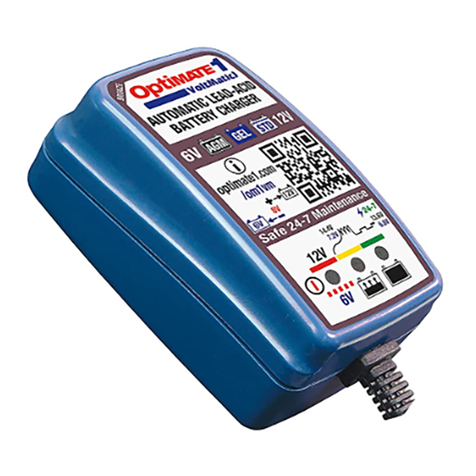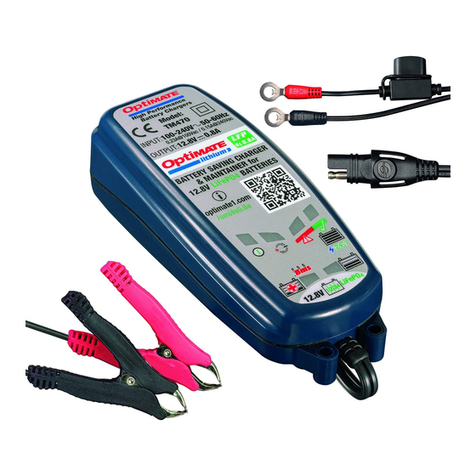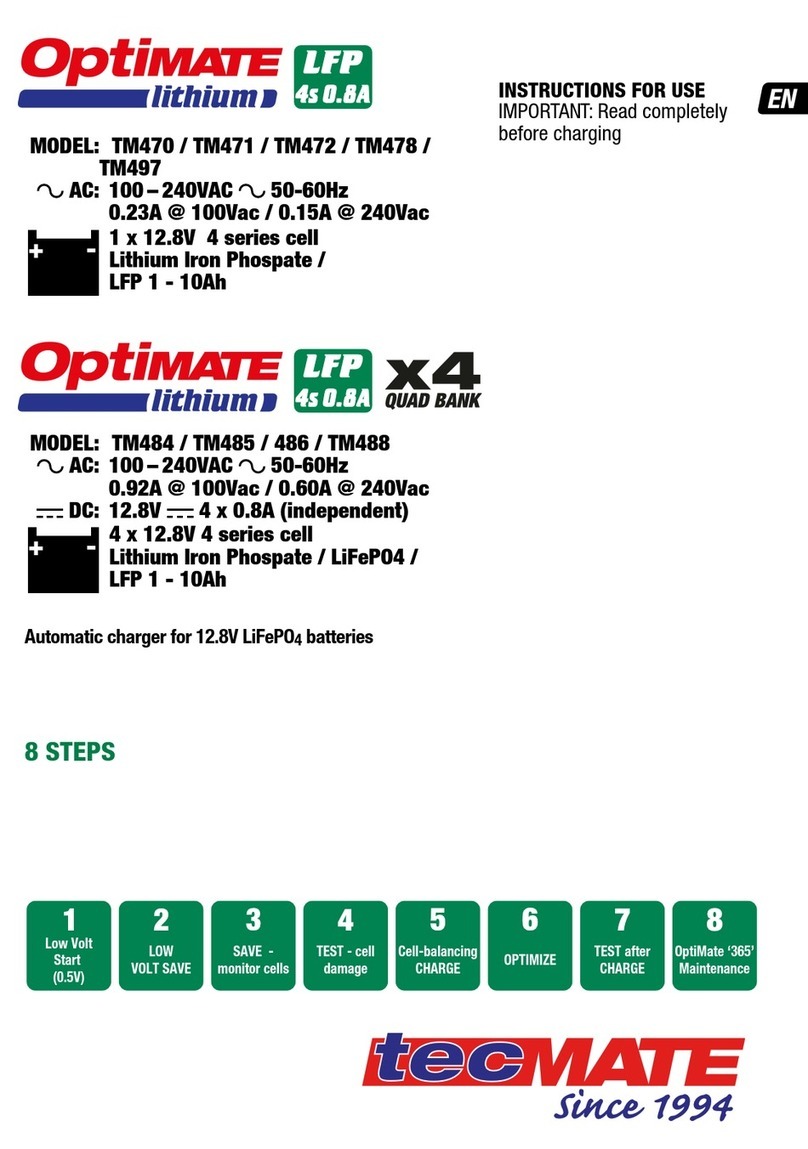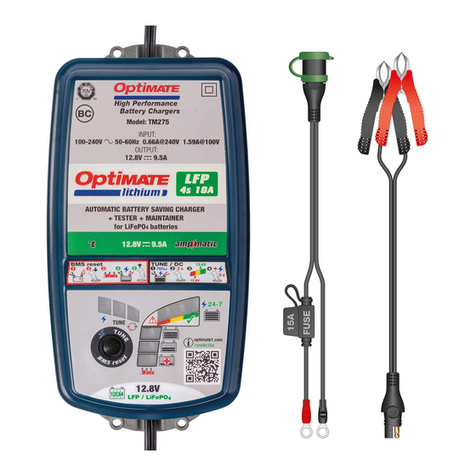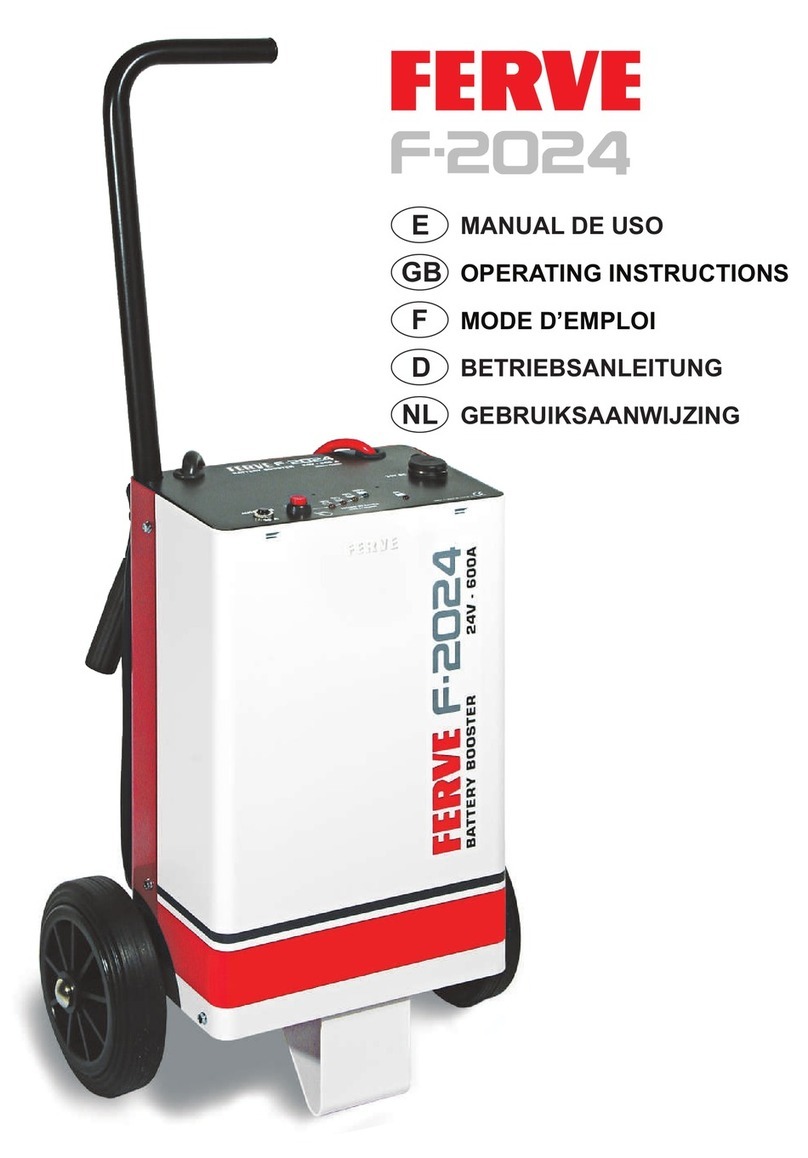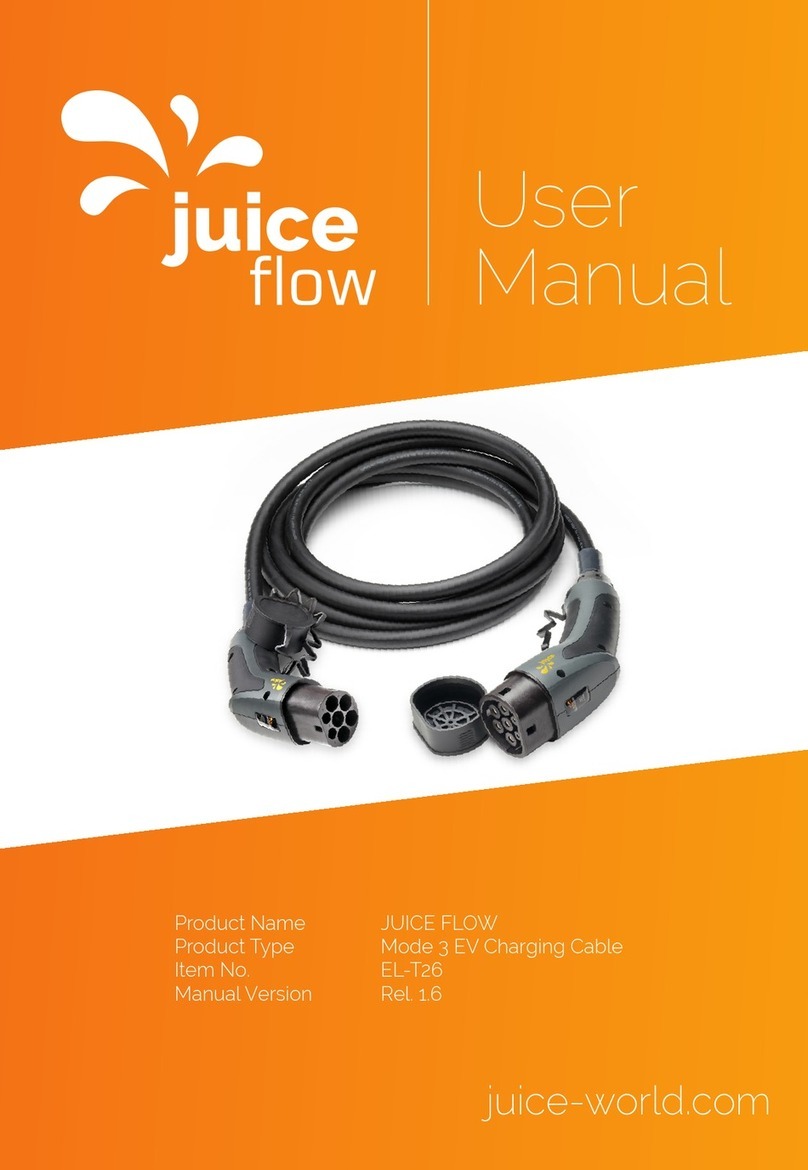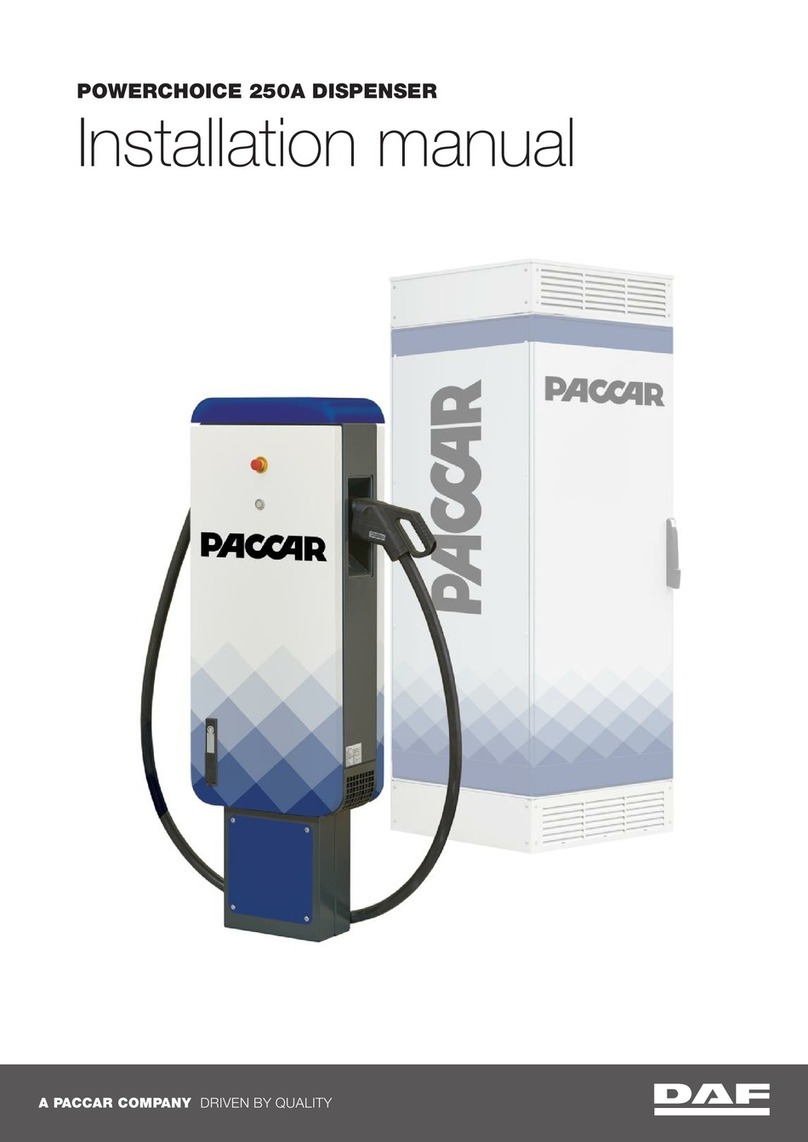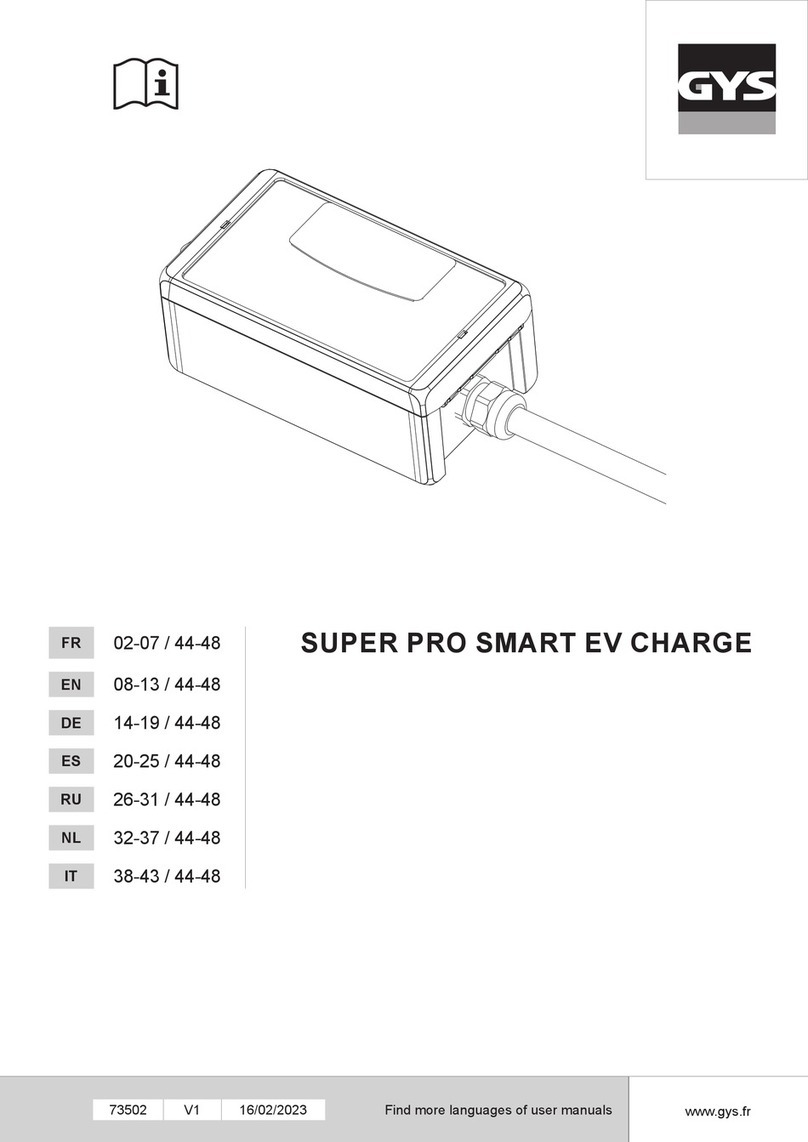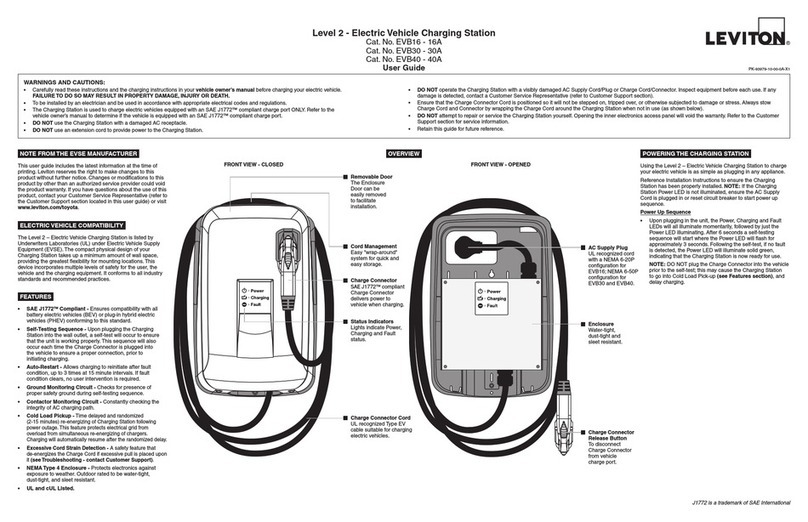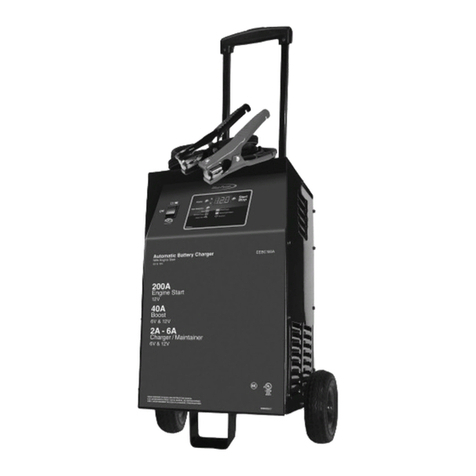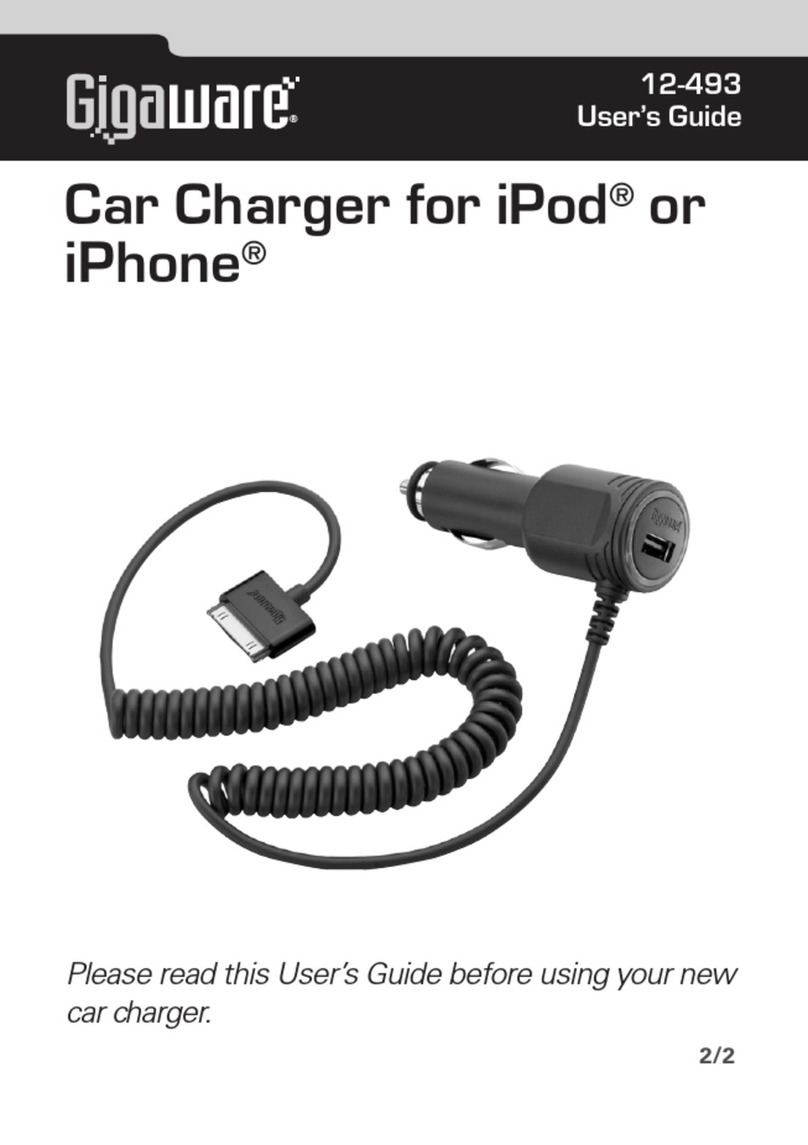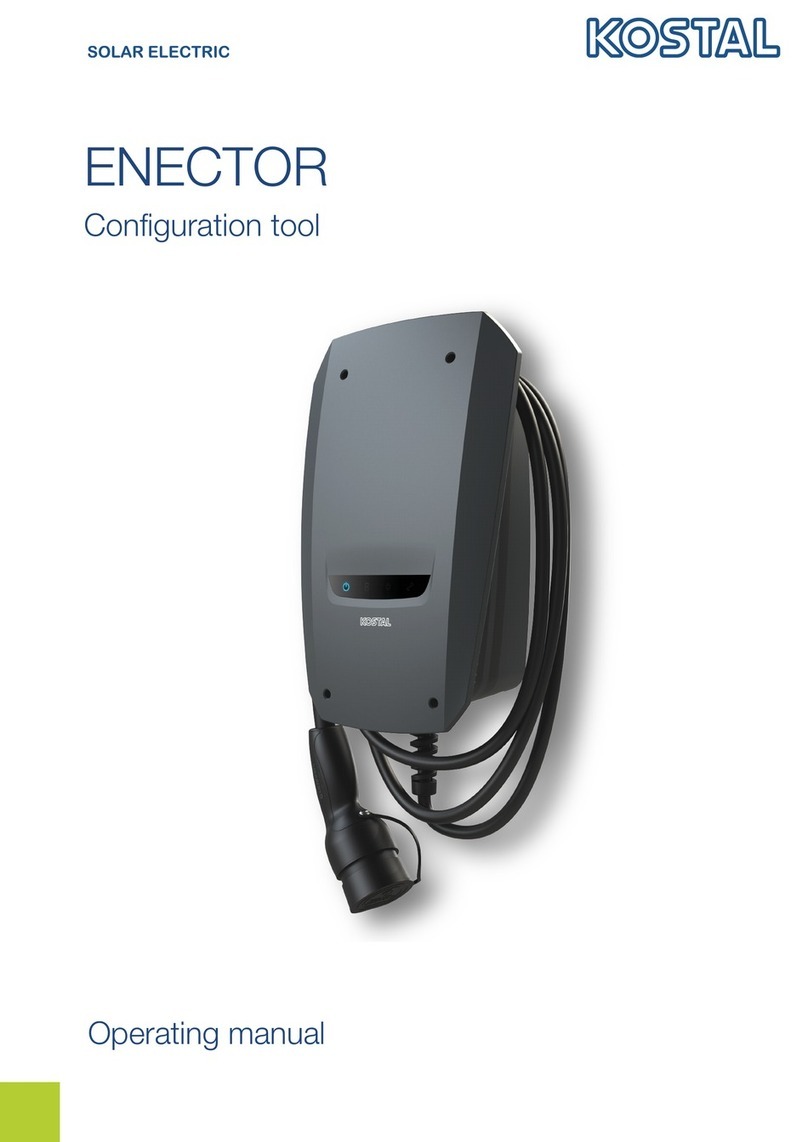TecMate Optimate 3 TM431 User manual

KK
ET
LV
DA
FI
NO
CS
HU
BG
SR
SK
SL
RO
LT
HR
TR
EL
JP
CN
Automatic charger for 12V lead-acid batteries • Chargeur automatique pour batteries
12V plomb-acide • Cargador automático para baterías 12V plomo-ácido • Carregador
automático para baterias de 12V chumbo-ácido • Automatische Ladegerät für 12V
Blei-Säure Batterien • Automatische lader voor 12V loodzuur accu’s • Caricabatterie
automatico per batterie 12V piombo-acido • Automatisk diagnostisk laddare för
12V blybatterier • Автоматическое зарядное устройство для 12В свинцово
кислотных аккумуляторных батарей
• 12V鉛バッテリー専用全自動バッテ
リー診断機能付充電器
• 適用於 12V 鉛酸電池的自動充電器
• Αυτόματος
φορτιστής για μπαταρίες μολύβδου-οξέος 12V • 12 V kurşun asit aküler için
otomatik şarj cihazı • Automatski punjač za olovne akumulatore od 12 V
• Automatinis 12 V švino rūgštinių akumuliatorių įkroviklis • Încărcător
automat pentru baterii plumb-acid de 12 V • Samodejni polnilnik za 12 V
svinčeno-kislinske akumulatorje • Automatická nabíjačka pre 12V olovené
akumulátory • Automatski punjač za olovno-kiselinske akumulatore od 12 V •
Автоматично зарядно устройство за 12 V оловно-киселинни акумулатори •
Automatikus töltő 12V-os ólomakkumulátorokhoz • Automatická nabíječka na
12V olověné baterie • Automatisk lader for 12V-blybatterier • Automaattinen
laturi 12 V:n lyijyakulle • Automatisk oplader til 12 V blysyrebatterier • 12V
svina-skābes akumulatoru automātiskais lādētājs • Automaatlaadija 12 V
pliiakude jaoks • 12 В қорғасын-қышқылды аккумуляторларға
арналған автоматты зарядтағыш
1 x 12V
STD / AGM-MF / GEL / CYCLIC CELL
2.5 - 38Ah
+ -
MODEL / 型號:
TM430 / TM431 / TM432 / TM438 / TM447
AC: 100 – 240VAC 50-60Hz
0.23A @ 100Vac / 0.15A @ 240Vac
DC: 0.8A 12V
2 x 12V
STD / AGM-MF / GEL / CYCLIC CELL
2.5 - 38Ah
+ -
MODEL / 型號:
TM450 / TM451 / TM452 / TM499
AC: 100 – 240VAC 50-60Hz
0.46A @ 100Vac / 0.30A @ 240Vac
DC: 2 x 0.8A 12V (independent)
4 x 12V
STD / AGM-MF / GEL / CYCLIC CELL
2.5 - 38Ah
+ -
MODEL / 型號:
TM454 / TM455 / TM457 / TM458
AC: 100 – 240VAC 50-60Hz
0.92A @ 100Vac / 0.60A @ 240Vac
DC: 4 x 0.8A 12V (independent)
copyright © 2021 TecMate International
TM430-IN1-211213
INSTRUCTIONS FOR USE
IMPORTANT: Read
completely before charging
MODE D’EMPLOI
IMPORTANT: à lire avant
d’utiliser l’appareil
ANWENDUNGSVORSCHRIFTEN
WICHTIG:
Vollständig vor der Benutzung lesen
GEBRUIKSAANWIJZING
BELANGRIJK: Lees
volledig voor gebruik
MODO DE EMPLEO
IMPORTANTE: a leer antes
de utilizar el aparato
INSTRUÇÕES DE UTILIZAÇÃO
IMPORTANTE:
Ler antes de utilizar.
ISTRUZIONI PER L’USO
IMPORTANTE: da
leggere prima di utilizzare l’apparecchio
INSTRUKTIONER
VIKTIGT: läs följande
fullständiga instruktioner för användningen innan du
använder laddaren
ИНСТРУКЦИЯ ПО ПРИМЕНЕНИЮ
ВАЖНО:
Прочти полностью перед использованием
取扱説明書
重要:充電器をご使用になる前に
本書を必ず最後までお読みください。
重要使用說明
充電前請完整閱讀
ΟΔΗΓΊΕΣ ΧΡΗΣΗΣ
ΣΗΜΑΝΤΙΚΟ: Διαβάστε
πλήρως πριν την φόρτιση
KULLANIM TALIMATLARI
ÖNEMLİ: Şarj
etmeden önce tüm bilgileri okuyun
UPUTE ZA UPOTREBU
VAŽNO: Pročitajte u
potpunosti prije punjenja.
NAUDOJIMO INSTRUKCIJOS
Svarbu:
Išsamiai perskaitykite prieš įkraudami
INSTRUCȚIUNI DE UTILIZARE
IMPORTANT:
Citiți în întregime înainte de a încărca
NAVODILA ZA UPORABO
POMEMBNO: Pred
polnjenjem navodila v celoti preberite
NÁVOD NA POUŽITIE
DÔLEŽITÉ: Pred
nabíjaním si prečítajte celý návod
UPUTSTVO ZA UPOTREBU
VAŽNO: Pročitajte
do kraja pre punjenja
ИНСТРУКЦИИ ЗА УПОТРЕБА
ВАЖНО:
Прочетете внимателно преди зареждане
HASZNÁLATI ÚTMUTATÓ
FONTOS: Töltés
előtt olvassa végig
POKYNY KPOUŽÍVÁNÍ
DŮLEŽITÉ: Než začnete
nabíjet, pročtěte si celý text
BRUKSANVISNING
VIKTIG: Les fullstendig før
du bruker laderen
KÄYTTÖOHJEET
TÄRKEÄÄ: Lue ohjeet kokonaan
ennen lataamista
BRUGSANVISNING
VIGTIGT: Læs hele teksten
før opladning
LIETOŠANAS INSTRUKCIJA
SVARĪGI! Pirms
uzlādes izlasiet līdz beigām
KASUTUSJUHEND
OLULINE! Lugege enne
laadimist täielikult läbi
ПАЙДАЛАНУ НҰСҚАУЛАРЫ
МАҢЫЗДЫ:
Зарядтау алдында толығымен оқыңыз

Multi bank / station models OptiMate 3 x2 OptiMate 3 x4:
each bank /station / output operates as an independent OptiMate 3.
マルチバンク/ステーションモデル OptiMate 3 x2 OptiMate 3 x4:
各バンク/ステーションの出力は、独立したOptiMate 3として動作しま
す。
多組/工作站型號 OptiMate 3 x2 OptiMate 3 x4
每組/工作站輸出作為獨立的 OptiMate 3 運行。
LED #1 AC POWER (100-240V)
LED #2 REVERSE POLARITY
LED #3 SAVE / SOC: 0 - 49%
LED #4 CHARGE / SOC: 50%+
LED #5 MAINTAIN / SOC: 100% /
SOH:
LED #6 BATTERY SOH:
12V
24-724-7
/om3
optimate1.com
/om3
1 5
2
3 4
6
SOC - State Of Charge
SOH - State Of Health

3
SAVE THESE INSTRUCTIONS. THIS PORTION OF THE MANUAL CONTAINS IMPORTANT SAFETY
INSTRUCTIONS FOR THE OPTIMATE 6 BATTERY CHARGER. IT IS OF THE UTMOST IMPORTANCE THAT
EACH TIME, BEFORE USING THE CHARGER, YOU READ AND EXACTLY FOLLOW THESE
INSTRUCTIONS.
Automatic charger for 12V lead-acid batteries. DO NOT USE FOR NiCd, NiMH, Li-Ion OR NON-
RECHARGEABLE BATTERIES.
1. CAUTION : DO NOT CONNECT TO GROUND.
2. Do not expose charger to rain or snow.
3. Use of an attachment not recommended or sold by the battery charger manufacturer may result in a risk of fire, electric
shock, or injury to persons.
4. To reduce risk of damage to electric plug and cord, pull by plug rather than cord when disconnecting charger.
5. An extension cord should not be used unless absolutely necessary. Use of improper extension cord could result
in a risk of fire and electric shock. If extension cord must be used make sure that :
a) pins on plug of extension cord are the same number, size and shape as those of plug on charger.
b) the extension cord is properly wired and in good electrical condition, and
c) the conductor wire size is large enough for the AC ampere rating of the charger as specified in the table below.
AC INPUT RATING IN AMPERES
Equal to or greater than But less than LENGTH OF CORD,
FEET (m) AWG SIZE
OF CORD
2A 3A 25 (17.6)
50 (15.2)
100 (30.5)
18
18
14
6. Do not operate charger with damaged cord or plug – replace the cord or plug immediately.
7. Do not operate charger if it has received a sharp blow, been dropped,or otherwise damaged in any way;
take it to a qualified serviceman.
8. Do not disassemble charger; take it to a qualified serviceman when service or repair is required.
Incorrect reassembly may result in a risk of electric shock or fire.
9. To reduce risk of electric shock, unplug the charger from outlet before attempting any maintenance or cleaning.
Turning off controls will not reduce this risk.Clean only with slightly moist,not wet, cloth.Do not use solvents.
10. WARNING - RISK OF EXPLOSIVE GASES.
a) WORKING IN VICINITY OF A LEAD-ACID BATTERY IS DANGEROUS. BATTERIES GENERATE EXPLOSIVE GASES
DURING NORMAL BATTERY OPERATION. FOR THIS REASON, IT IS OF UTMOST IMPORTANCE THAT YOU FOLLOW THE
INSTRUCTIONS EACH TIME YOU USE THE CHARGER.
b) To reduce risk of battery explosion, follow these instructions and those published by the battery manufacturer
and manufacturer of any equipment you intend to use in vicinity of the battery. Review cautionary marking on
these products and on engine.
11. PERSONAL PRECAUTIONS.
a) Someone should be within range of your voice OR close enough to come to your aid when you work near a lead-acid
battery.
b) Have plenty of fresh water and soap nearby in case battery acid contacts skin, clothing or eyes.
c) Wear complete eye protection and clothing protection. Avoid touching eyes while working near battery.
d) If battery acid contacts or enters eye, flood eye with cold running water for at least 10 minutes and get medical attention
immediately. If battery acid contacts skin or clothing, wash immediately with soap and water. If acid enters an eye,
immediately flood eye with running cold water for at least 10 minutes and get medical attention immediately.
e) NEVER smoke or allow a spark or flame in vicinity of battery or engine.
f) Be extra cautious to reduce risk of dropping a metal tool onto battery. It might spark or short-circuit battery or other
electrical part that may cause explosion.
g) Remove personal metal items such as rings, bracelets, necklaces, and watches when working with a lead-acid battery. A
lead-acid battery can produce a short-circuit current high enough to weld a ring or the like to metal, causing a severe burn.
i) NEVER charge a frozen battery.
12. PREPARING TO CHARGE
IMPORTANT SAFETY INSTRUCTIONS FOR CANADA & USA

4
IMPORTANT SAFETY INSTRUCTIONS FOR CANADA & USA (cont.)
a) If necessary to remove battery from vehicle to charge,always remove grounded terminal from battery first.
Make sure all accessories in the vehicle are off, so as not to cause an arc.
b) Be sure area around battery is well ventilated while battery is being charged. Gas can be forcefully blown
away by using a piece of cardboard or other non-metallic material as a fan.
c) Clean battery terminals. Be careful to keep corrosion from coming in contact with eyes.
d) Add distilled water in each cell until battery acid reaches level specified by battery manufacturer. This helps purge excessive
gas from cells. Do not overfill. For a battery without cell caps, such as valve regulated lead acid (VRLA) or absorbed glass mat
(AGM) batteries, carefully follow manufacturer’s recharging instructions.
e) Study all battery manufacturer’s specific precautions such as removing or not removing cell caps while charging and
recommended rates of charge.
f) Determine voltage of battery by referring to vehicle or battery user’s manual and BEFORE
MAKING THE BATTERY CONNECTIONS, MAKE SURE THAT THE VOLTAGE OF THE BATTERY YOU ARE
GOING TO CHARGE MATCHES THE OUTPUT VOLTAGE OF THE CHARGER.
13. CHARGER LOCATION.
a) Locate charger as far away from battery as DC cables permit.
b) Never place charger directly above batterv being charged; gases from battery will corrode and damage the charger.
c) Never allow battery acid to drip on charger when reading gravity or filling battery. Do not operate charger in a closed-in area or
restrict ventilation in any way.
d) Do not set a battery on top of charger. IMPORTANT : Place charger on a hard flat surface or mount onto a vertical surface. Do
not place on plastic, leather or textile surface.
14. DC CONNECTION PRECAUTIONS
a) Connect and disconnect DC output clips only after setting any charger switches to off position and removing AC cord from
electric outlet. Never allow clips to touch each other, however should this happen no damage will result to the charger circuit &
the automatic charging programme will just reset to «start».
b) Attach clips to battery and chassis as indicated in 15(e), 15(f), and 16(b) through 16(d).
NOTE : This battery charger has an automatic safety feature that will prevent it from operating if
the battery has been inversely connected. Set charger switches to off position and/or remove AC cord from
electrical outlet, disconnect the battery clips, then reconnect correctly according to the instructions below.
15. FOLLOW THESE STEPS WHEN BATTERY IS INSTALLED IN VEHICLE. A SPARK NEAR A BATTERY
MAY CAUSE BATTERY EXPLOSION. TO REDUCE RISK OF A SPARK NEAR BATTERY :
a) Position AC and DC cords so as to reduce risk of damage by hood, door or moving engine part.
b) Stay clear of fan -blades, belts,pulleys,and other parts that can cause injury to persons.
c) Check polarity of battery posts.POSITIVE (POS, P, +) battery post usually has larger diameter than NEGATIVE (NEG, N,–) post.
d) Determine which post of battery is grounded (connected) to the chassis. If negative post is grounded to chassis
(as in most vehicles), see (e). If positive post is grounded to the chassis, see (f).
e) For negative-grounded vehicle, connect POSITIVE (RED) clip from battery charger to POSITIVE (POS, P, + ) ungrounded post of
battery. Connect NEGATIVE (BLACK) clip to vehicle chassis or engine block away from battery. Do not connect clip to carburetor,
fuel lines, or sheet-metal body parts. Connect to a heavy gage metal part of the frame or engine block.
f) For positive-grounded vehicle, connect NEGATIVE (BLACK) clip from battery charger to NEGATIVE (NEG. N , -) ungrounded post
of battery. Connect POSITIVE (RED) clip to vehicle chassis or engine block away from battery. Do not connect clip to carburetor,
fuel lines, or sheet-metal body parts. Connect to a heavy gage metal part of the frame or engine block.
g) When disconnecting charger, turn switches to off, disconnect AC cord,remove clip from vehicle chassis, and then remove clip
from battery terminal.
h) See operating instructions for length of charge information.
16. FOLLOW THESE STEPS WHEN BATTERY IS OUTSIDE VEHICLE. A SPARK NEAR THE BATTERY MAY
CAUSE BATTERY EXPLOSION. TO REDUCE RISK OF A SPARK NEAR BATTERY :
a) Check polarity of battery posts. POSITIVE (POS, P, +) battery post usually has a larger diameter than NEGATIVE (NEG,N, -) post.
b) This battery charger has an automatic safety feature that will prevent it from operating if the
battery has been inversely connected. The charger does not allow charge current unless a voltage
of at least 2V is sensed.
c) Connect POSITIVE (RED) charger clip to POSITIVE (POS, P, +) post of battery.
d) Connect NEGATIVE (BLACK) charger clip to NEGATIVE (NEG, N, -) battery post of the battery.
e) Do not face battery when making final connection.
f) When disconnecting charger, always do so in reverse sequence of connecting procedure & break first connection while as far
away from battery as practical.
g) A marine (boat) battery must be removed & charged on shore. To charge it on board requires equipment specially designed for
marine use.

5
AUTOMATIC MAINTENANCE CHARGER FOR 12V LEAD-ACID BATTERIES
FROM 2.5Ah TO 38Ah, AS FOUND IN:
DO NOT USE FOR NiCd, NiMH, Li-Ion OR NON-RECHARGEABLE BATTERIES.
Charge rate: 0,8 Ah / hour, will recharge a 38Ah battery in 48 hours.
Input: 100-240V maximum 0,23A. The maximum output current is 0,8A.
IMPORTANT: READ THE FOLLOWING INSTRUCTIONS BEFORE USING THE CHARGER
This appliance can be used by children aged from 8 years and above and persons with
reduced physical,sensory or mental capabilities or lack of experience and knowledge if
they have been given supervision or instruction concerning use of the appliance in a safe
way and understand the hazards involved. Children shall not play with the appliance.
Cleaning and user maintenance shall not be made by children without supervision.
SAFETY WARNING AND NOTES: Batteries emit EXPLOSIVE GASES - prevent flame or sparks near batteries. Disconnect
AC power supply before making or breaking DC/battery connections. Battery acid is highly corrosive. Wear protective clothing and eyewear and
avoid contact. In case of accidental contact, wash immediately with soap and water. Check that the battery posts are not loose; if so, have the
battery professionally assessed. If the battery posts are corroded, clean with a copper wire brush; if greasy or dirty clean with a rag damped in
detergent. Use the charger only if the input and output leads and connectors are in good, undamaged condition. If the input cable is
damaged, it is essential to have it replaced without delay by the manufacturer, his authorised
service agent or a qualified workshop, to avoid danger. Protect your charger from acid and acid fumes and from damp
and humid conditions both during use and in storage. Damage resulting from corrosion, oxidation or internal electrical short-circuiting is not
covered by warranty. Distance the charger from the battery during charging to avoid contamination by or exposure to acid or acidic vapours. If
using it in the horizontal orientation, place the charger on a hard, flat surface, but NOT on plastic, textile or leather. Use the fixing holes provided
in the enclosure base to attach the charger to any convenient, sound vertical surface.
EXPOSURE TO LIQUIDS: This charger is designed to withstand exposure to liquids accidentally spilled or splashed onto the
casing from above, or to light rainfall. Prolonged exposure to falling rain is inadvisable and longer service life will be obtained by minimizing
such exposure.Failure of the charger due to oxidation resulting from the eventual penetration of liquid into the electronic components,
connectors or plugs,is not covered by warranty.
BATTERY CONNECTIONS: 2 interchangeable connection sets are available, supplied with the charger is a set of battery clips for
charging the battery off-vehicle, the other connection set comes with metal eyelet lugs for permanent connection to the battery posts, and
re-sealable weatherproof cap on the connector that connects to the charger output cable. This connection set allows easy and sure
connection of the charger to maintain the battery on-vehicle. The resealable weatherproof cap is designed to protect the connector from dirt
and damp whenever the charger is not attached. Consult a professional service agent for assistance in attaching the metal eyelets to the
battery posts. Secure the connector with weatherproof cap so that it cannot foul any moving part of the vehicle or the cable can be pinched
or damaged by sharp edges. The in-line fuse in the eyelets connection set protects the battery against such accidental shorting across
positive and negative conductors. Replace any burnt fuse only with a similar new fuse of 15A rating.
CONNECTING THE CHARGER TO THE BATTERY
1. Disconnect AC power supply before making or breaking DC / battery connections.
2. If charging a battery in the vehicle with the battery clips, before making connections, first check that the battery clips can be safely
and securely positioned clear from surrounding wiring, metal tubing or the chassis. Make connections in the following order:
First connect to the battery terminal not connected to the chassis (normally positive),
then connect the other battery clip (normally negative) to the chassis well away
from the battery and fuel line. Always disconnect in reverse sequence.
3. When charging a battery out of the vehicle with the battery clips, place it in a well ventilated area. Connect the charger to the battery:
RED clamp to POSITIVE (POS, P or +) terminal and BLACK clamp to NEGATIVE (NEG, N or –) terminal. Make sure the connections are
firm and secure. Good contact is important.
4. If the battery is deeply discharged (and possibly sulphated), remove from the vehicle and inspect the battery before
connecting the charger for a recovery attempt.
Visually check the battery for mechanical defects such as a bulging or cracked
casing, or signs of electrolyte leakage. If the battery has filler caps and the plates within the cells can be seen from the outside, examine
SAFETY

6
the battery carefully to try to determine if any cells seem different to the others (for example, with white matter between the plates,
plates touching). If mechanical defects are apparent do not attempt to charge the battery, have the battery professionally assessed.
5. If the battery is new, before connecting the charger read the battery manufacturer’s safety and operational instructions carefully. If
applicable, carefully and exactly follow acid filling instructions.
USING THE OPTIMATE 3: PROCEEDING TO CHARGE
For safety reasons, the OptiMate output will only activate if a battery retaining at least 2V is connected.
VERY FLAT NEGLECTED BATTERIES: Pay particularly close attention to the following which is especially important for
relatively small batteries such as those used on motorcycles, lawn tractors, jet-ski’s, snowmobiles and similar: A battery left
deep-discharged for an extended period may develop permanent damage in one or more cells. Such batteries may heat up excessively
during high current charging.
Monitor the battery temperature during the first hour, then hourly there-after. Check for unusual signs, such as bubbling or leaking
electrolyte, heightened activity in one cell compared to others, or hissing sounds. If at any time the battery is uncomfortably hot to touch or
you notice any unusual signs, DISCONNECT THE CHARGER IMMEDIATELY.
ECO POWER SAVING MODE WHEN THE CHARGER IS CONNECTED TO AC SUPPLY: The power converter
switches to ECO mode when the charger is not connected to a battery resulting in a very low power draw of less than 0,5W, equivalent to
power consumption of 0,012 kWh per day. When a battery is connected to the charger power consumption depends on the current demand
of the battery and its connected vehicle / electronic circuitry. After the battery has been charged and the charger is in long term
maintenance charge mode (to keep the battery at 100% charge) the total power consumption is estimated to be 0,060 kWh or less per day.
The LED indicators referred to below, and the clauses dealing with them, are sequenced as they may come on through the course
of the program.
1 5
12V
24-724-7
/om3
optimate1.com
/om3
1 5
2
3 4
6
1. LED #1 - Power on. Confirms AC power supply to the charger. 2. LED #2 indicates inverse
polarity - wrong output connections. Swap around to activate output.
3. LED #3 SAVE lights if battery voltage at connection is between 2V and 12.4V, indicating
the 12V battery is deep discharged and possibly sulphated.
3.1 DEEP DISCHARGE SAVE of deep discharged / sulphated batteries removed from
the vehicle* -Output voltage increases to a maximum of 20V with low current limited to
0.2A, to overcome high level of sulphation that is preventing charge acceptance, then it
progresses to PULSE SAVE.
* IMPORTANT: The charger’s deep discharge SAVE mode cannot engage if it senses that the
battery is still connected to a vehicle wiring circuit which effectively offers a lower
electrical resistance than the battery on its own. No damage to vehicle electronics will
occur, but battery may not fully recover. Remove from vehicle and try again!
3.2 PULSE SAVE - current up to 0.8A is delivered in pulses up to a voltage of 14.3V to
prepare the battery to accept normal charge. Time in SAVE mode: 15min to 2 hours.
4. LED #4 CHARGE & VERIFICATION
4.1 CHARGE: Charging starts here for batteries measuring 12.4V at connection. A constant
current of 0.8 Amps is delivered to the battery, up to a voltage of 14.3 -14.5V.
4.2 VERIFICATION / PULSE ABSORPTION: Battery charge level is verified. If the battery

7
requires further charging the OptiMate will deliver charge until the battery’s current
demand drops below 200mA at 13.6V. (see expected Charging time below.)
NOTE: For safety reasons there is an overall charge time limit of 48 hours.
5. BATTERY READY / 24-7 Maintenance active: LED #5 on.
The battery can be used. If left connected (recommended), battery health is confirmed,
followed by the OptiMate 24-7 maintenance that maintains the battery at full charge.
5.1 Health test starts immediately after LED #5 lights.
Delivery of current to the battery is
interrupted for up to
12**hours
to allow the battery to settle and confirm that the vehicle circuitry
is not depleting the battery.
** If charge delivery was less than 12h up to when LED #5
turned on, health test extends until 24h has elapsed, followed by 24-7 maintenance.
5.2 OptiMate 24-7 maintenance: LED #5 (green) confirms the battery is is healthy and
holding charge. During every hour that the battery remains connected OptiMate's 24-7
maintenance program delivers 30 minutes of float charge maintenance at a voltage of 13.6V,
followed and alternating wih 30 minute REST (no charging) periods. OptiMate will counter
discharge by connected circuitry or battery self-discharge. The OptiMate 24-7 50% duty
cycle maintenance program is designed to eliminate loss of electrolyte in a sealed lead acid
battery whilst keeping the battery fully charged and healthy. TIP: At least once every two
weeks, check battery status. IMPORTANT: in the case of STD batteries with removable filler
caps, check the level of the electrolyte and if necessary, disconnect the battery from the
charger, top up the cells (with distilled water, NOT acid), then reconnect. When handling
batteries or in their vicinity, always take care to observe the SAFETY WARNINGS above.
6. LED #6 flashing / blinking - BATTERY is not holding charge.
If the red LED #6 lights a significant problem exists. The battery’s voltage is not being
sustained above 12.4V (equal to 50% charge in a sealed AGM battery) or could not be
sufficiently recovered. In the case of a battery still connected to the electrical system it
supports, the red LED #6 may be signalling a loss of current through connected wiring or
'always on' current-consuming accessories. A sudden load such as vehicle headlights being
switched on while the charger is connected can also cause the battery voltage to dip
significantly.
The OptiMate will try recharge the battery again and then repeat the health test as described
in point 5 above. LED #5 will light if the battery’s charge level has improved.
Charging time: The time required for the OptiMate 3 to complete a charge on a flat but
otherwise undamaged battery is roughly equal to the battery’s Ah rating, so a 10Ah battery
should take no more than about 10 hours to progress to Step 4. Deep-discharged batteries
may take significantly longer.
LIMITED WARRANTY
TecMate (International) SA, Sint-Truidensesteenweg 252, B-3300 Tienen, Belgium, makes this limited warranty to the original purchaser at
retail of this product. This limited warranty is not transferable. TecMate (International) warrants this battery charger for three years from date
of purchase at retail against defective material or workmanship. If such should occur the unit will be repaired or replaced at the option of the
manufacturer. It is the obligation of the purchaser to forward the unit together with proof of purchase (see NOTE), transportation or mailing
costs prepaid, to the manufacturer or its authorized representative. This limited warranty is void if the product is misused, subjected to
careless handling, or repaired by anyone other than the factory or its authorized representative. The manufacturer makes no warranty other
than this limited warranty and expressly excludes any implied warranty including any warranty for consequential damages.
THIS IS THE ONLY EXPRESS LIMITED WARRANTY AND THE MANUFACTURER NEITHER ASSUMES NOR AUTHORIZES ANYONE TO ASSUME OR
MAKE ANY OTHER OBLIGATION TOWARDS THE PRODUCT OTHER THAN THIS EXPRESS LIMITED WARRANTY. YOUR STATUTORY RIGHTS ARE
NOT AFFECTED.
NOTE: Details at www.tecmate.com/warranty.
WARRANTY in Canada, USA, Central America & South America: TecMate North America, Oakville, ON, Canada, as a wholy owned
subsidiary of TecMate International, assumes the responsibility for product warranty in these regions.
OptiMate 3, OptiMate or any product ending in 'MATE' are registered trademarks of TecMate International NV. More at www.tecmate.com.

88
CONSERVER CES INSTRUCTIONS. CE MANUEL CONTIENT DES INSTRUCTIONS
IMPORTANTES CONCERNANT LA SÉCURITÉ ET LE FONCTIONNEMENT DU
CHARGEUR OPTIMATE 6.
CHARGEUR AUTOMATIQUE POUR BATTERIES 12V PLOMB-ACIDE
NE CONVIENT PAS POUR LES BATTERIES NiCd, NiMH, Li-Ion OU NON RECHARGEABLES.
AVERTISSEMENT :
N’utiliser l’appareil qu’à l’intérieur. Ne pas exposer à la pluie ou à la neige.
a) CONSERVER CES INSTRUCTIONS. CE MANUEL CONTIENT DES INSTRUCTIONS IMPORTANTES CONCERNANT LA SÉCURITÉ
ET LE FONCTIONNEMENT.
b) IL EST DANGEREUX DE TRAVAILLER A PROXIMITÉ D’UNE BATTERIE AU PLOMB. LES BATTERIES PRODUISENT DES GAZ
EXPLOSIFS EN SERVICE NORMAL. IL EST AUSSI IMPORTANT DE TOUJOURS RELIRE LES INSTRUCTIONS AVANT D’UTILISER
LE CHARGEUR ET DE LES SUIVRE À LA LETTRE.
c) POUR RÉDUIRE LE RISQUE D’EXPLOSION, LIRE CES INSTRUCTIONS ET CELLES QUI FIGURENT SUR LA BATTERIE.
d) NE JAMAIS FUMER PRÈS DE LA BATTERIE OU DU MOTEUR ET ÉVITER TOUTE ÉTINCELLE OU FLAMME NUE À PROXIMITÉ
DE CES DERNIERS.
e) UTILISER LE CHARGEUR POUR CHARGER UNE BATTERIE AU PLOMB UNIQUEMENT. CE CHARGEUR N’EST PAS CONÇU
POUR ALIMENTER UN RÉSEAU ÉLECTRIQUE TRÈS BASSE TENSION NI POUR CHARGER DES PILES SÈCHES. LE FAIT
D’UTILISER LE CHARGEUR POUR CHARGER DES PILES SÈCHES POURRAIT ENTRAÎNER L’ÉCLATEMENT DES PILES ET
CAUSER DES BLESSURES OU DES DOMMAGES.
f) NE JAMAIS CHARGER UNE BATTERIE GELÉE.
g) S’IL EST NÉCESSAIRE DE RETIRER LA BATTERIE DU VÉHICULE POUR LA CHARGER, TOUJOURS DÉBRANCHER LA BORNE
DE MISE À LA MASSE EN PREMIER. S’ASSURER QUE LE COURANT AUX ACCESSOIRES DU VÉHICULE EST COUPÉ AFIN
D’ÉVITER LA FORMATION D’UN ARC.
h) PRENDRE CONNAISSANCE DES MESURES DE PRÉCAUTION SPÉCIFIÉES PAR LE FABRICANT DE LA BATTERIE, P. EX.,
VÉRIFIER S‘IL FAUT ENLEVER LES BOUCHONS DES CELLULES LORS DU CHARGEMENT DE LA BATTERIE, ET LES TAUX DE
CHARGEMENT RECOMMANDÉS.
i) SI LE CHARGEUR COMPORTE UN SÉLECTEUR DE TENSION DE SORTIE, CONSULTER LE MANUEL DE L’USAGER DE LA
VOITURE POUR DÉTERMINER LA TENSION DE LA BATTERIE ET POUR S’ASSURER QUE LA TENSION DE SORTIE EST
APPROPRIÉE. SI LE CHARGEUR N’EST PAS MUNI D’UN SÉLECTEUR, NE PAS UTILISER LE CHARGEUR À MOINS QUE LA
TENSION DE LA BATTERIE NE SOIT IDENTIQUE À LA TENSION DE SORTIE NOMINALE DU CHARGEUR.
j) NE JAMAIS PLACER LE CHARGEUR DIRECTEMENT SOUS LA BATTERIE À CHARGER OU AU-DESSUS DE CETTE DERNIÈRE.
LES GAZ OU LES FLUIDES QUI S’ÉCHAPPENT DE LA BATTERIE PEUVENT ENTRAÎNER LA CORROSION DU CHARGEUR OU
L’ENDOMMAGER. PLACER LE CHARGEUR AUSSI LOIN DE LA BATTERIE QUE LES CABLES C.C. LE PERMETTENT.
k) NE PAS FAIRE FONCTIONNER LE CHARGEUR DANS UN ESPACE CLOS ET/OU NE PAS GÊNER LA VENTILATION.
l) METTRE LES INTERRUPTEURS DU CHARGEUR HORS CIRCUIT ET RETIRER LE CORDON C.A. DE LA PRISE AVANT DE
METTRE ET D’ENLEVER LES PINCES DU CORDON C.C. S’ASSURER QUE LES PINCES NE SE TOUCHENT PAS.
m) SUIVRE LES ÉTAPES SUIVANTES LORSQUE LA BATTERIE SE TROUVE DANS LE VÉHICULE.
UNE ÉTINCELLE PRÈS DE LA BATTERIE POURRAIT PROVOQUER L’EXPLOSION DE CETTE DERNIÈRE. POUR RÉDUIRE LE
RISQUE D’ÉTINCELLE À PROXIMITÉ DE LA BATTERIE :
(i) PLACER LES CORDONS C.A. ET C.C. DE MANIÈRE À ÉVITER QU’ILS SOIENT ENDOMMAGÉS PAR LE CAPOT,
UNE PORTIÈRE OU LES PIÈCES EN MOUVEMENT DU MOTEUR ;
(ii) FAIRE ATTENTION AUX PALES, AUX COURROIES ET AUX POULIES DU VENTILATEUR AINSI QU’À
TOUTE AUTRE PIÈCE SUSCEPTIBLE DE CAUSER DES BLESSURES ;
(iii) VÉRIFIER LA POLARITÉ DES BORNES DE LA BATTERIE. LE DIAMÈTRE DE LA BORNE POSITIVE
(POS, P, +) EST GÉNÉRALEMENT SUPÉRIEUR À CELUI DE LA BORNE NÉGATIVE (NÉG, N, –) ;
(iv) DÉTERMINER QUELLE BORNE EST MISE À LA MASSE (RACCORDÉE AU CHÂSSIS). SI LA BORNE
CANADA: INSTRUCTIONS IMPORTANTE CONCERNANT LA SÉCURITÉ

99
CANADA: INSTRUCTIONS IMPORTANTE CONCERNANT LA SÉCURITÉ
NÉGATIVE EST RACCORDÉE AU CHÂSSIS (COMME DANS LA PLUPART DES CAS), VOIR LE POINT (v). SI LA
BORNE POSITIVE EST RACCORDÉE AU CHÂSSIS, VOIR LE POINT (vi) ;
(v) SI LA BORNE NÉGATIVE EST MISE À LA MASSE, RACCORDER LA PINCE POSITIVE (ROUGE) DU
CHARGEUR À LA BORNE POSITIVE (POS, P, +) NON MISE À LA MASSE DE LA BATTERIE. RACCORDER LA
PINCE NÉGATIVE (NOIRE) AU CHÂSSIS DU VÉHICULE OU AU MOTEUR, LOIN DE LA BATTERIE. NE PAS
RACCORDER LA PINCE AU CARBURATEUR, AUX CANALISATIONS D’ESSENCE NI AUX PIÈCES DE LA CARROSSERIE
EN TÔLE. RACCORDER À UNE PIÈCE DU CADRE OU DU MOTEUR EN TÔLE DE FORTE
ÉPAISSEUR ;
(vi) SI LA BORNE POSITIVE EST MISE À LA MASSE, RACCORDER LA PINCE NÉGATIVE (NOIRE) DU
CHARGEUR À LA BORNE NÉGATIVE (NÉG, N, –) NON MISE À LA MASSE DE LA BATTERIE. RACCORDER
LA PINCE POSITIVE (ROUGE) AU CHÂSSIS DU VÉHICULE OU AU MOTEUR, LOIN DE LA BATTERIE. NE
PAS RACCORDER LA PINCE AU CARBURATEUR, AUX CANALISATIONS D’ESSENCE NI AUX PIÈCES DE LA
CARROSSERIE EN TÔLE. RACCORDER À UNE PIÈCE DU CADRE OU DU MOTEUR EN TÔLE DE FORTE ÉPAISSEUR ;
(vii) BRANCHER LE CORDON D’ALIMENTATION C.A. DU CHARGEUR ;
(viii) POUR INTERROMPRE L’ALIMENTATION DU CHARGEUR, METTRE LES INTERRUPTEURS HORS
CIRCUIT, RETIRER LE CORDON C.A. DE LA PRISE, ENLEVER LA PINCE RACCORDÉE AU CHÂSSIS ET EN
DERNIER LIEU CELLE RACCORDÉE À LA BATTERIE.
n) SUIVRE LES ÉTAPES SUIVANTES LORSQUE LA BATTERIE EST À L’EXTÉRIEUR DU VÉHICULE.
UNE ÉTINCELLE PRÈS DE LA BATTERIE POURRAIT PROVOQUER L’EXPLOSION DE CETTE DERNIÈRE. POUR RÉDUIRE LE
RISQUE D’ÉTINCELLE À PROXIMITÉ DE LA BATTERIE :
(i) VÉRIFIER LA POLARITÉ DES BORNES DE LA BATTERIE. LE DIAMÈTRE DE LA BORNE POSITIVE
(POS, P, +) EST GÉNÉRALEMENT SUPÉRIEUR À CELUI DE LA BORNE NÉGATIVE (NÉG, N, –) ;
(ii) RACCORDER UN CÂBLE DE BATTERIE ISOLÉ No 6 AWG MESURANT AU MOINS 60 CM DE
LONGUEUR À LA BORNE NÉGATIVE (NÉG, N, –) ;
(iii) RACCORDER LA PINCE POSITIVE (ROUGE) À LA BORNE POSITIVE (POS, P, +) DE LA BATTERIE ;
(iv) SE PLACER ET TENIR L’EXTRÉMITÉ LIBRE DU CÂBLE AUSSI LOIN QUE POSSIBLE DE LA BATTERIE,
PUIS RACCORDER LA PINCE NÉGATIVE (NOIRE) DU CHARGEUR À L’EXTRÉMITÉ LIBRE DU CÂBLE ;
(v) NE PAS SE PLACER FACE À LA BATTERIE POUR EFFECTUER LE DERNIER RACCORDEMENT ;
(vi) RACCORDER LE CORDON D’ALIMENTATION C.A. DU CHARGEUR À LA PRISE ;
(vii) POUR INTERROMPRE L’ALIMENTATION DU CHARGEUR, METTRE LES INTERRUPTEURS HORS
CIRCUIT, RETIRER LE CORDON C.A. DE LA PRISE, ENLEVER LA PINCE RACCORDÉE AU CHÂSSIS ET EN
DERNIER LIEU CELLE RACCORDÉE À LA BATTERIE. SE PLACER AUSSI LOIN QUE POSSIBLE DE LA BATTERIE
POUR DÉFAIRE LA PREMIÈRE CONNEXION.

10
SÉCURITÉ
CHARGEUR AUTOMATIQUE À FONCTION DIAGNOSTIC POUR BATTERIES
PLOMB-ACIDE À PARTIR DE 2,5AH - 38AH, COMME CELLES DES :
NE CONVIENT PAS POUR LES BATTERIES NiCd, NiMH, Li-Ion
OU NON RECHARGEABLES.
Taux de charge : 0,8Ah / heure, capable de recharger en 48 heures une batterie de 38Ah.
Entrée : 100-240V maximum 0,23A. Le courant de sortie maxi est 0,8A.
IMPORTANT : LIRE ENTIÈREMENT LES INSTRUCTIONS SUIVANTES
AVANT D’UTILISER LE CHARGEUR
Cet appareil n'est pas destiné à être utilisé par des personnes (y compris des enfants) possédant
des capacités physiques, sensorielles ou mentales réduites, ou manquant d'expérience et de
connaissance, sauf si elles bénéficient d'une surveillance ou ont reçu des instructions concernant
l'utilisation de l'appareil d'une personne responsable de leur sécurité. Les enfants doivent faire
l'objet d'une surveillance pour s'assurer qu'ils ne jouent pas avec l'appareil.
AVERTISSEMENT DE SÉCURITÉ et REMARQUES :Les batteries émettent des GAZ EXPLOSIFS - il faut
interdire les flammes ou les étincelles à proximité.
Avant d’établir ou de rompre les connexions de courant continu à la batterie, déconnecter l’alimentation secteur. L’acide des batteries est un
puissant corrosif. Porter des vêtements et lunettes protecteurs et éviter tout contact. En cas de contact accidentel, laver immédiatement à
l’eau et au savon. S’assurer que les bornes des batteries ne sont pas branlantes ; le cas échéant la batterie doit subir une évaluation
professionnelle. Si les bornes sont corrodées, nettoyer à l’aide d’une brosse de cuivre ; s’ils sont gras ou sales, nettoyer à l’aide d’un
torchon trempé dans du détergent. Utiliser uniquement le chargeur si les câbles et connecteurs d’entrée et de sortie sont en bon état et non
endommagés. Si le câble d’entrée est endommagé, il est essentiel de le faire remplacer par le constructeur, son agent de service autorisé
ou un atelier qualifié, pour éviter tout danger. Protéger le chargeur contre les acides et fumées acides, l’humidité et un environnement
humide, aussi bien durant l’usage que l’entreposage. Les dégâts résultant de la corrosion, de l’oxydation ou de courts-circuits internes ne
sont pas couverts par la garantie. Durant le chargement, éloigner le chargeur de la batterie pour éviter la contamination par l’acide ou les
vapeurs acides ou l’exposition à ceux-ci. En cas d’utilisation horizontale, placer le chargeur sur une surface dure et plane, PAS en plastique,
tissu ou cuir. Utiliser les trous de fixation de la base pour fixer le chargeur sur toute surface verticale appropriée et solide.
EXPOSITION AUX LIQUIDES : Ce chargeur est conçu pour résister à l’exposition aux liquides qui tomberaient accidentellement sur
le boîtier, ou à une pluie légère. Une exposition prolongée à des liquides tombants ou à la pluie est à déconseiller. Une durée de vie
supérieure résultera d’une telle précaution. Une panne due à l’oxydation résultant d’une pénétration de liquide dans les composants
électroniques,blocs connecteurs ou fiches,ne sera pas couverte par la garantie.
CONNEXIONS DE BATTERIE : l’appareil est livré avec deux jeux de connexion interchangeables, l’un muni de pinces crocodiles
pour le chargement de batteries hors véhicule, l’autre, optionnel, disposant de cosses à œillets pour la connexion permanente aux bornes de
batterie, ainsi que d’un capuchon résistant aux intempéries réouvrable sur le connecteur relié au chargeur. Ce jeu de connexion permet la
connexion sûre et facile du chargeur à la batterie sur véhicule. Le capuchon résistant aux intempéries réouvrable est conçu pour protéger le
connecteur contre la saleté et l’humidité lorsque le chargeur n’est pas connecté. Consulter un agent de service professionnel pour toute
assistance à la connexion des œillets métalliques aux bornes de batterie. Assurer le connecteur avec le capuchon résistant aux intempéries
de manière à ce qu’il ne puisse gêner aucune pièce mobile du véhicule et pour éviter le pincement du câble ou son endommagement par
des bords tranchants. Le fusible en ligne du jeu de connecteurs à œillets protège la batterie contre le court-circuitage accidentel des pôles
positif et négatif. Remplacer un fusible sauté uniquement par un autre similaire de 15A.
BRANCHEMENT DU CHARGEUR A LA BATTERIE
1. Débranchez l'alimentation secteur avant d'effectuer un branchement CC/batterie ou de le débrancher.
2. Si vous chargez une batterie installée dans le véhicule avec les pinces pour batterie, avant les branchements, vérifiez d'abord que les
pinces pour batterie peuvent être positionnées en toute sécurité loin du câblage voisin, d'un tube métallique ou du châssis. Respectez
l'ordre qui suit : branchez d'abord la borne de la batterie non raccordée au châssis (normalement positive) puis, branchez l'autre
pince pour batterie (normalement négative) au châssis à un endroit bien éloigné de la batterie et du conduit de carburant. Débranchez
toujours dans l'ordre inverse.
10

11
3. Lorsque vous chargez une batterie hors du véhicule avec les pinces pour batterie, placez-la dans un endroit bien ventilé. Branchez le
chargeur à la batterie : La pince ROUGE sur la borne POSITIVE (POS, P ou +) et la pince NOIRE sur la borne NÉGATIVE (NEG, N ou
–).Vérifiez que les branchements sont bien fixés. Un bon contact est important.
4. Si la batterie est complètement déchargée (et probablement sulfatée), retirez-la du véhicule et inspectez la batterie avant de
brancher le chargeur pour une tentative de récupération. Vérifiez visuellement la batterie à la recherche de défauts mécaniques
tels qu'un gonflement ou un boîtier craquelé ou encore de signes de fuite d'électrolyte. Si la batterie présente des bouchons de
remplissage et que les plaques des cellules sont visibles de l'extérieur, examinez soigneusement la batterie pour tenter de déterminer
si certaines cellules semblent différentes des autres (par exemple, de la matière blanche entre les plaques, les plaques qui entrent en
contact). Si vous avez détecté des défauts mécaniques, ne chargez pas la batterie et faites-la examiner par un professionnel.
5. Si la batterie est neuve, avant de brancher le chargeur, lisez attentivement les instructions d'utilisation et de sécurité fournies par le
fabricant de la batterie. Si besoin est, suivez attentivement et exactement les instructions relatives au remplissage de l'acide.
UTILISATION DE L’OPTIMATE 3: COMMENCER LA CHARGE
Pour des raisons de sécurité, la sortie de l’Optimate sera uniquement activée s’il est connecté à une batterie disposant d’un
minimum de 2V.
BATTERIES NÉGLIGÉES TRÈS DÉCHARGÉES : Tenir spécialement compte de ce qui suit, surtout pour
les batteries relativement petites comme celles des motos, tracteurs à gazon, jet ski, motoneiges
et similaires : Les cellules d’une batterie restée en décharge profonde durant une longue période peuvent être endommagées à titre
permanent. Ces batteries peuvent chauffer excessivement durant la charge à courant élevé.
Vérifier la température de batterie durant la première heure, puis chaque heure suivante. Vérifier la présence de signes inhabituels comme des
bulles ou fuites d’électrolyte, une activité plus importante d’une cellule par rapport aux autres, ou des sifflements. Si à un moment quelconque,
la batterie devient trop chaude au toucher ou si vous constatez des signes inhabituels, DECONNECTER IMMÉDIATEMENT LE CHARGEUR.
MODE ÉCONOMIE D'ÉNERGIE LORSQUE LE CHARGEUR EST CONNECTÉ A L'ALIMENTATION SECTEUR :
Le convertisseur d'énergie se désactive et passe en mode ECO lorsque le chargeur est déconnecté de la batterie, la puissance consommée
diminuant jusque 0,5W, l'équivalent d'une consommation d'énergie de 0,012 kWh par jour. Lorsqu'une batterie est branchée au chargeur, la
consommation d'énergie dépend de la demande en courant de la batterie et du véhicule/des circuits électroniques raccordés. Une fois que
la batterie est chargée et que le programme de charge est en mode de charge d'entretien à long terme (pour garder la batterie chargée à
100 %), la consommation d'énergie totale est estimée à 0,060 kWh ou moins par jour.
Les indications LED évoquées ci-dessous et les textes qui s'y rapportent apparaissent dans l'ordre de déroulement logique du
programme.
1 5
12V
24-724-7
/om3
optimate1.com
/om3
1 5
2
3 4
6
1. VOYANT LED nº 1 : mise sous tension. Confirme l'alimentation secteur vers le chargeur.
2. VOYANT LED nº 2 : indique une polarité inverse : mauvaises connexions de sortie. Intervertir les connexions pour
activer la sortie.
3. VOYANT LED nº 3 RÉCUPÉRATION : s'allume si la tension de la batterie est comprise entre 2 V et 12,4 V au moment
du raccordement, et indique que la batterie 12 V est profondément déchargée et probablement sulfatée.
3.1 RÉCUPÉRATION DE LA DÉCHARGE PROFONDE de batteries profondément déchargées/sulfatées et retirées
du véhicule* - La tension de sortie augmente jusqu'à atteindre 20 V maximum avec un faible courant de 0,2 A pour
dépasser le haut niveau de sulfatation qui empêche l'acceptation de charge, et ensuite passer en mode
RÉCUPÉRATION PAR IMPULSIONS.
* IMPORTANT : le mode RÉCUPÉRATION du chargeur ne se déclenche pas s'il capte une connexion entre la batterie
et le circuit électrique du véhicule qui présente effectivement une résistance électrique inférieure à celle de la
batterie seule. L'électronique du véhicule ne subira aucun dommage, mais la batterie pourrait ne pas récupérer
11

12
entièrement. Retirez-la du véhicule et essayez à nouveau !
3.2 RÉCUPÉRATION PAR IMPULSIONS : un courant pouvant atteindre 0,8 A est envoyé par impulsions et peut atteindre
une tension de 14,3 V afin de préparer la batterie à accepter une charge normale. Autonomie en mode de
RÉCUPÉRATION : 15 min à 2 heures.
4. VOYANT LED nº 4 CHARGE: Charge et Vérification
4.1 CHARGE : la charge commence à ce moment pour les batteries mesurant 12,4 V au moment du raccordement. Un
courant constant de 0,8 A est envoyé à la batterie, à une tension de 14,3-14,5 V.
4.2 VÉRIFICATION/ABSORPTION PAR IMPULSIONS : le niveau de charge de la batterie est vérifié. Si la batterie nécessite
une charge supplémentaire, l'OptiMate fournit une charge jusqu'à ce que la demande en courant de la batterie chute
sous 200 mA à 13,6 V (voir le temps de charge prévu ci-dessous).
REMARQUE : pour des raisons de sécurité, il existe une limite de temps de charge absolue de 48 heures.
5. VOYANT LED n°5 MAINTENANCE: BATTERIE PRÊTE À L'EMPLOI / Maintenance active 24 h/24, 7 j/7
La batterie peut être utilisée. Si l'état de la batterie restée connectée (recommandé) est confirmé suite à la
maintenance OptiMate 24 h/24, 7 j/7 qui maintient la batterie en charge complète.
5.1 Le test permettant de définir l'état de la batterie commence immédiatement après que le voyant nº 5 s'est allumé.
L'arrivée du courant dans la batterie est interrompue pendant 12** heures afin de permettre à la batterie de se
stabiliser et de confirmer que le faisceau électrique du véhicule ne vide pas la batterie. ** Si lorsque le voyant nº 5
s'allume, la charge a duré moins de 12 heures, le test se prolonge jusqu'à ce que 24 heures se soient
écoulées. Une maintenance 24 h/24, 7 j/7 sera ensuite effectuée.
5.2 Maintenance OptiMate 24 h/24, 7 j/7 : le voyant nº 5 (vert) confirme que la batterie est saine et capable de retenir
les charges. Toutes les heures durant lesquelles la batterie reste connectée, le programme de maintenance OptiMate
24 h/24, 7 j/7 envoie une charge tampon de maintenance de 30 minutes à une tension de 13,6 V, en alternance avec
des périodes de repos de 30 minutes (pas de charge). L'OptiMate empêche la décharge provoquée par le circuit relié
ou l'autodécharge de la batterie. Le programme de maintenance basé sur un cycle de fonctionnement de 50 % est
conçu pour éviter la perte d'électrolyte d'une batterie plomb-acide tout en maintenant la batterie complètement
chargée et saine. Conseil : Tous les 15 jours minimum, vérifiez l'état de la batterie. IMPORTANT : s'il s'agit d'une
batterie STD dotée de bouchons de remplissage amovibles, vérifiez le niveau d'électrolyte et, si nécessaire,
déconnectez la batterie du chargeur, remplissez les cellules (avec de l'eau distillée, et NON de l'acide), et
reconnectez-la ensuite. Respectez toujours les CONSIGNES DE SÉCURITÉ décrites ci-dessus lorsque vous
manipulez des batteries ou que vous vous trouvez à proximité de celles-ci.
6. VOYANT LED nº 6 TESTE -- clignotant : la BATTERIE ne retient pas la charge.
Le voyant LED nº 6 rouge s'allume si un problème sérieux se présente. La tension de la batterie n'est pas maintenue
au-dessus de 12,4 V (50 % de la charge dans une batterie AGM scellée) ou la batterie n'a pu être suffisamment
récupérée. Si la batterie est toujours branchée sur le système électrique qui l'alimente, il est possible que le voyant
LED nº 6 rouge indique une perte de courant liée à un câble ou à des accessoires consommateurs de courant qui
restent « tout le temps allumés ». Une consommation soudaine, telle que l'allumage des phares du véhicule, alors que
le chargeur est branché peut également causer une baisse significative de la tension de la batterie. L'OptiMate tente
alors de charger la batterie à nouveau et effectue le test permettant de connaître l'état de celle-ci comme décrit au
point 5 ci-dessus. Le voyant LED nº 5 s'allume si le niveau de charge de la batterie s'est amélioré. Temps de charge :
le temps nécessaire à l'OptiMate 3 pour charger complètement une batterie déchargée, mais intacte, correspond à
peu près à la capacité nominale en Ah de la batterie. Une batterie de 10 Ah a donc besoin d'environ 10 heures pour
passer à l'étape 4. Des batteries profondément déchargées peuvent nécessiter beaucoup plus de temps.
GARANTIE LIMITÉE TecMate International SA, Sint-Truidensesteenweg 252, B-3300 Tienen, Belgique, consent la présente
garantie au premier client utilisateur de ce produit, sans possibilité de transfert. TecMate (International) garantit ce chargeur pendant trois
ans à compter de la date d’achat au détail contre les défauts de composants ou d’assemblage. Le cas échéant, le chargeur sera réparé ou
remplacé à la discrétion du fabricant. L’acheteur doit expédier, à ses frais, l’appareil ainsi qu’une preuve d’achat (voir "NOTE") au fabricant
ou à son représentant agréé. Cette garantie limitée devient nulle si l’appareil est utilisé ou manipulé de façon inadéquate ou s’il a été réparé
par toute personne physique ou morale autre que le fabricant ou un représentant agréé. Le fabricant n’offre aucune autre garantie que la
présente, et exclut expressément toute garantie contre les dommages conséquentiels.
CECI EST LA SEULE GARANTIE EXPRESSÉMENT CONSENTIE PAR LE FABRICANT. CELUI-CI N’ASSUME ET N’AUTORISE QUICONQUE A ASSUMER
OU ETABLIR TOUTE AUTRE OBLIGATION LIÉE À CE PRODUIT, AUTRE QUE CETTE GARANTIE LIMITÉE EXPRESSÉMENT CONSENTIE. VOS
DROITES STATUTAIRES NE SONT PAS AFFECTÉES.
NOTE : Voir www.tecmate.com/warranty ou contactez [email protected] - OptiMate 3 et les noms des autresappareilsmentionnés
dans ce texte tels queBatteryMate, TestMate et TestMate mini, sont des marques déposées de TecMate International SA.
On peut trouver plus d'information surles produits deTecMate chez www.tecmate.com.

13
SEGURIDAD
CARGADOR DE DIAGNÓSTICO AUTOMÁTICO PARA BATERÍAS DE PLOMO
ÁCIDO DE 12 V A PARTIR DE 2,5AH - 38AH ENCONTRADAS EN:
NO UTILIZAR CON BATERÍAS DE NiCd, NiMH, Li-Ion O BATERÍAS NO RECARGABLES.
Tasa de carga: 0,8Ah / hora, una batería de 38Ah tardará 48 horas en recargarse.
Entrada: 100-240V máximo 0,23A. La corriente máxima de salida está 0,8A.
IMPORTANTE: LEA COMPLETAMENTE LAS SIGUIENTES INSTRUCCIONES
ANTES DE UTILIZAR EL CARGADOR
Este aparato no está concebido para que lo utilicen personas (incluidos niños) con capacidades
físicas, sensoriales o mentales disminuidas, o bien con falta de experiencia y conocimientos, a
menos que una persona responsable de su seguridad las supervise o les dé instrucciones sobre el
uso del aparato. Es necesario supervisar a los niños para asegurarse de que no juegan con el
aparato.
AVISOS Y PRECAUCIONES DE SEGURIDAD: Las baterías emiten GASES EXPLOSIVOS, evite la posibilidad de llamas o
chispas cerca de las baterías. Desconecte la corriente CA antes de realizar o deshacer conexiones de la batería CC. El ácido de la batería es
altamente corrosivo. Utilice ropa y gafas de protección y evite el contacto con el ácido. En caso de contacto accidental, enjuague inmediatamente
la zona afectada con agua y jabón. Compruebe que los polos de la batería no estén sueltos, y si lo están, lleve la batería a un servicio técnico. Si
los bornes presentan corrosión, límpielos con un cepillo de hilo de cobre, y si presentan grasa o suciedad, límpielos con un trapo humedecido en
detergente. Utilice el cargador solamente si los cables y conectores de entrada y salida se encuentran en bunas condiciones y sin daños. Si el
cable de entrada está dañado, es fundamental que el fabricante, el servicio técnico autorizado o un taller capacitado lo sustituyan sin demora
para evitar riesgos. Proteja el cargador del ácido y de las emisiones de gases de ácido y de ambientes húmedos o superficies mojadas durante
su utilización y almacenamiento. La garantía no cubre daños derivados de la corrosión, oxidación o cortocircuitos eléctricos internos. Coloque el
cargador a una distancia adecuada de la batería durante la recarga para evitar la contaminación o la exposición al ácido o vapores de ácido. Si
se utiliza en posición horizontal, coloque el cargador en una superficie dura y plana, PERO NUNCA sobre plástico, tela o piel. Utilice los orificios
de fijación de la base de la carcasa para fijar el cargador en una superficie cómoda y totalmente horizontal.
EXPOSICIÓN A LÍQUIDOS: Este cargador fue desarrollado para resistir a líquidos que hubieran sido derramados de forma
accidental o a intemperies ligeras. No obstante, no se recomiendan las exposiciones prolongadas, que podrían menguar la duración de vida
del cargador. Los desgastes, resultado de la oxidación debida al ataque eventual de líquidos en los componentes electrónicos, los
conectadores o enchufes no se cubren por la garantía
CONEXIONES DE BATERÍA: Hay disponibles 2 juegos de conectores intercambiables, se suministra con el cargador un juego de
pinzas de batería para recargarla fuera del vehículo, el juego de conexión opcional tiene unos orificios metálicos para conectarlos
permanentemente a los bornes de la batería y una tapa impermeable resellable en el conector que conecta al cable de salida del cargador.
Este tipo de conector permite una conexión fácil y segura al cargador sin tener que sacar la batería del vehículo. La tapa impermeable
resellable está diseñada para proteger el conector de la suciedad y la humedad cuando el cargador no esté conectado. Pregunte a un
mecánico profesional antes de conectar el conector de orificios a los bornes de la batería. Asegure los tapones impermeables a los
conectores para evitar que se enganchen con alguna pieza móvil del vehículo o estropeen o dañen algún cable con los bordes afilados. El
fusible en línea del juego de conectores con orificios protege la batería frente a cortocircuitos accidentales entre los conductores positivo y
negativo. Sustituya los fusibles quemados con un fusible nuevo similar de 15 A.
CONEXIÓN DEL CARGADOR A LA BATERÍA
1. Desconecte el suministro de CA antes de efectuar o deshacer las conexiones de CC / batería.
2. Si se va a cargar una batería montada en el vehículo con las pinzas, compruebe primero que las pinzas se pueden colocar de forma
segura y correcta, lejos del cableado, los tubos metálicos o el bastidor, antes de efectuar las conexiones. Realice las conexiones en
este orden: realice primero la conexión al terminal de la batería que no está conectado con el bastidor (normalmente positivo), luego
conecte la otra pinza de batería (normalmente negativa) al bastidor a una distancia suficiente de la batería y de la tubería de
combustible. Desconecte siempre realizando los pasos anteriores en orden inverso.
3. Cuando cargue una batería fuera del vehículo con las pinzas, colóquela en un lugar bien ventilado. Conecte el cargador a la batería:
pinza ROJA con el terminal POSITIVO (POS, P o +) y pinza NEGRA con el terminal NEGATIVO (NEG, N o –).Asegúrese de que las
conexiones son firmes y seguras. Es importante que hagan bien contacto.

14
4. Si la batería está excesivamente descargada (y posiblemente sulfatada), retírela del vehículo e inspecciónela antes de
conectar el cargador para intentar recuperarla. Examine visualmente la batería en busca de desperfectos mecánicos, como combas
o fisuras en la carcasa, o indicios de fugas de electrólito. Si la batería tiene tapones de llenado y se pueden ver desde fuera las placas
del interior de las células, examine detenidamente la batería para comprobar si hay células que parezcan distintas de las demás (por
ejemplo, con materia blanca entre las placas o placas en contacto). Si se han detectado desperfectos mecánicos, no intente cargar la
batería, encargue su evaluación a personal cualificado.
5. Si la batería es nueva, lea atentamente las instrucciones de seguridad y uso del fabricante de la misma antes de conectar el cargador.
En su caso, siga estrictamente las instrucciones de llenado de ácido.
UTILIZACIÓN DEL OPTIMATE 3: INICIAR LA CARGA
Por motivos de seguridad, la corriente de salida del OptiMate se activará solamente si hay conectada una batería con al menos 2V.
BATERÍAS DESECHADAS TOTALMENTE DESCARGADAS: Preste especial atención a los siguientes puntos, que son
especialmente importantes en el caso de baterías relativamente pequeñas, como pueden ser de motocicletas, tractores de jardín,
motos de agua, motos de nieve y similares: Una batería que haya permanecido descargada durante un periodo largo de tiempo puede
desarrollar daños permanentes en una o más celdas. Esas baterías pueden calentarse en exceso durante la carga de alta tensión. Detenga
inmediatamente la carga de la batería si está demasiado caliente al tacto.
Controle la temperatura de la batería durante la primera hora, a partir de entonces, contrólela cada hora. Permanezca atento a señales
inusuales, como pueden ser el burbujeo o la fuga de electrolito, una mayor actividad en una pila en comparación con las otras o sonidos
silbantes. Si en cualquier momento la batería está demasiado caliente o nota cualquier señal que no sea normal, DESCONECTE EL CARGADOR
INMEDIATAMENTE.
MODO DE AHORRO DE ENERGÍA ECO CUANDO EL CARGADOR ESTÁ CONECTADO AL SUMINISTRO DE
CA: El convertidor de energía pasa al modo ECO cuando el cargador no está conec tado a una batería, por lo que el consumo de corriente es
muy bajo (inferior a 0,5 W), lo que equivale a un consumo de energía de 0,012 kWh al día. Cuando la batería está conectada al cargador, el
consumo de energía varía en función de la cantidad de corriente que necesiten la batería y los circuitos del vehículo / electrónicos conectados
a la misma. Una vez que se ha cargado la batería y el programa de carga está en el modo de carga de mantenimiento prolongado (para
mantener la batería a plena carga), el consumo total de energía estimado es de 0,060 kWh o menos por día.
Las indicaciones LED evocadas a continuación y los textos relacionados aparecen según el orden de secuencia lógico del programa.
1 5
12V
24-724-7
/om3
optimate1.com
/om3
1 5
2
3 4
6
1. LED n.º1: alimentación activada. Confirma que el cargador recibe suministro de CA.
2. LED n.º2: indica que la polaridad es inversa y que las conexiones de salida no son correctas. Intercámbielas para
activar la salida.
3. El LED n.º3 de RECUPERACIÓN se enciende si la tensión de la batería en la conexión se encuentra entre 2y 12,4V, lo
que indica que la batería de 12V está muy descargada y posiblemente sulfatada.
3.1 La RECUPERACIÓN DE DESCARGA PROFUNDA para baterías muy descargadas o sulfatadas ha sido retirada del
vehículo* - La tensión de salida aumenta hasta un máximo de 20V con la corriente baja limitada a 0,2A para solucionar
el elevado nivel de sulfatación que impide la aceptación de carga, después, continúa con la RECUPERACIÓN POR
IMPULSOS.
* IMPORTANTE: el modo SAVE (recuperación) de descarga profunda del cargador no puede activarse si detecta que la
batería sigue conectada a un circuito de cableado del vehículo, que ofrece de forma efectiva una resistencia eléctrica
inferior a la propia batería. No se producirán daños en la electrónica del vehículo, pero puede que la batería no se
recupere por completo. Retírela del vehículo y vuelva a intentarlo.
3.2 RECUPERACIÓN POR IMPULSOS: se suministra una corriente de hasta 0,8A en impulsos con una tensión de 14,3V,
como máximo, a fin de preparar la batería para que acepte la carga normal. Tiempo en el modo SAVE (recuperación): de
15minutos a 2horas.

15
4. LED n.º4 CARGA: Carga y Verificatión
4.1 CARGA: la carga comienza aquí en las baterías de 12,4V en la conexión. Se suministra una corriente constante de
0,8amperios a la batería, con una tensión máxima de 14,3-14,5V.
4.2 VERIFICACIÓN/ABSORCIÓN DE IMPULSOS: se verifica el nivel de carga de la batería. Si la batería necesita más carga,
OptiMate la suministrará hasta que la demanda actual de la batería haya caída por debajo de los 200mA en 13,6V
(consulte el apartado «Tiempo de carga» que encontrará más abajo).
NOTA: por razones de seguridad, hay un límite total de tiempo de carga de 48horas.
5. LED n.º5 MANTENIMIENTO: BATERÍA LISTA/Mantenimiento 24-7 continuo activado: .
La batería puede usarse. Si se deja conectada (recomendado), se confirma el estado de la batería, después, se realiza el
mantenimiento continuo de OptiMate que mantiene la batería con carga plena.
5.1 La comprobación del estado se inicia inmediatamente después de que se encienda el LED n.º5. El suministro de
corriente a la batería se interrumpe durante 12**horas, como máximo, para que la batería pueda asentarse y para
confirmar que la red eléctrica del vehículo no la está agotando. ** Si el suministro de la carga fue inferior a 12horas
cuando el LED n.º5 se encendió, la comprobación del estado se amplía hasta que hayan transcurrido 24horas
y, a continuación, se realiza el mantenimiento continuo.
5.2 Mantenimiento continuo de OptiMate: El LED n.º5 (verde) confirma que la batería está en buen estado y mantiene
la carga. Cada hora que la batería permanece conectada al programa de mantenimiento continuo de OptiMate, este
suministra 30minutos de mantenimiento de carga flotante en una tensión de 13,6V, seguido y alternado con periodos
de 30minutos de DESCANSO (sin carga). OptiMate contará la descarga a través del circuito conectado o la
autodescarga de la batería. El 50% del programa de mantenimiento continuo del ciclo de servicio de OptiMate está
diseñado para eliminar la pérdida de electrólito en una batería plomo-ácido sellada, al tiempo que mantiene la batería
completamente cargada y en buen estado. CONSEJO: compruebe el estado de la batería cada dos semanas, como
mínimo. IMPORTANTE: en el caso de las baterías STD con tapones de relleno extraíbles, compruebe el nivel del
electrólito y, si es preciso, desconecte la batería del cargador, recargue las celdas (con agua destilada, NO ácido) y
vuelva a conectarla. Cuando manipule baterías o se encuentre cerca de ellas, asegúrese siempre de seguir las
ADVERTENCIAS DE SEGURIDAD indicadas anteriormente.
6. LED n.º6 TESTE parpadeando: la BATERÍA no mantiene la carga. Si el LED rojo n.º 6 se enciende, existe un
problema importante. La tensión de la batería no puede mantenerse por encima de los 12,4V (lo que equivale
aproximadamente al 50% de la carga de una batería AGM sellada) o no puede recuperarse lo suficiente. Si una batería
sigue conectada al sistema eléctrico al que alimenta, el LED rojo n.º6 puede indicar una pérdida de corriente en los
cables conectados o que los accesorios que consumen corriente están encendidos de forma permanente. Un deslastre
súbito (como el producido al encender los faros del vehículo mientras el cargador está conectado) también puede
provocar que la tensión de la batería se reduzca drásticamente.
OptiMate intentará recargar la batería de nuevo y repetirá la comprobación del estado como se indica en el punto 5. El
LED n.º5 se encenderá si el nivel de carga de la batería ha mejorado.
Tiempo de carga: el tiempo necesario para que OptiMate 3 complete la carga de una batería descargada, pero sin
daños, equivale, aproximadamente, a la clasificación Ah de la batería. Por ejemplo, una batería de 10Ah no debería
tardar más de 10horas en llegar al paso4. Con las baterías muy descargadas, puede tardar mucho más.
GARANTÍA LIMITADA
TecMate (International) SA, Sint-Truidensesteenweg 252, B-3300 Tienen, Bélgica, establece esta garantía limitada en favor del primer
propietario que utilice este aparato. Esta garantía limitada no es transferible. TecMate (International) garantiza este aparato durante los tres
años siguientes a la fecha de compra por su primer usuario contra las fallos de materiales y de montaje. En este caso y a discreción del
fabricante el aparato podrá ser reparado ó reemplazado. La gestión y los costes relativos al transporte del aparato acompañado por una
prueba de compra (véase "NOTA") al fabricante ó a uno de sus representantes autorizados serán por cuenta del cliente. Esta garantía
limitada se anula en caso de uso ó tratamiento inadecuado, ó de reparación hecha por toda persona o organización otra diferente al
fabricante ó uno de sus representantes autorizados. El fabricante no cumple con otra garantía que esta garantía limitada y expresamente
excluye toda forma de garantía contra otros daños que los que sufra el aparato por sí mismo.
ESTO CONSTITUYE LA UNICA GARANTÍA LIMITADA VALIDA. El FABRICANTE NO RECONOCE A QUIENQUIERA EL DERECHO DE EJERCER Ó DE
TRANSMITIR NINGUN DERECHO RELATIVO AL PRODUCTO VENDIDO QUE SEA OTRO QUE EL QUE SE DERIVA DE ESTA GARANTÍA LIMITADA
EXPRESA. LAS SUS DERECHAS ESTATUTARIAS NO SON AFECTADAS.
NOTA: Véase www.tecmate.com/warranty ó contacte [email protected] - OptiMate 3 y los nombres de los otros aparatos
mencionados en este texto como BatteryMate, TestMate y TestMate mini, son marcas registradas de TecMate International SA.
Se puede encontrar más información sobre los productos de TecMate en www.tecmate.com.

16
SEGURANÇA
CARREGADOR DE DIAGNÓSTICO AUTOMÁTICO PARA BATERIAS DE
CHUMBO-ÁCIDO DE 12V A PARTIR DE 2,5AH - 38AH, COMO SE PODE
ENCONTRAR EM:
NÃO UTILIZAR PARA BATERIAS NiCd, NiMH, Li-Ion OU BATERIAS NÃO
RECARREGÁVEIS.
Corrente de carga: 0,8Ah/hora, carregará uma bateria de 38Ah em 48 horas.
Entrada: 100-240V máximo 0,23A. A corrente máxima de saída é 0,8A.
IMPORTANTE: LEIA AS SEGUINTES INSTRUCÇÕES DE UTILIZAÇÃO
ANTES DE UTILIZAR O CARREGADOR
Este dispositivo não se destina a ser utilizado por pessoas (incluindo crianças) com capacidades mentais, sensoriais ou físicas
diminuídas, nem por pessoas com falta de experiência ou conhecimentos, a não ser que recebam supervisão ou instruções
adequadas, dadas por uma pessoa responsável pela sua segurança, no que respeita ao seu uso. As crianças devem ser
supervisionadas de modo a assegurar que não brinquem com o dispositivo.
AVISO DE SEGURANÇA e NOTAS: As baterias emitem GASES EXPLOSIVOS - evitar chamas ou faíscas perto de baterias.
Desligue a alimentação de CA antes de efectuar ou remover ligações à CC/bateria. O ácido da bateria é altamente corrosivo. Usar vestuário
de protecção, equipamento para os olhos e evitar o contacto. Em caso de contacto acidental, lavar imediatamente com água e sabão.
Verifique se os terminais da bateria não estão soltos; se estiverem, peça a um profissional para avaliar a bateria. Se os terminais da bateria
estiverem corroídos, limpe-os com uma escova de fio de cobre; se estiverem oleosos ou sujos, limpe-os com um trapo humedecido em
detergente. Apenas utilize o carregador se os fios e os dispositivos de ligação de entrada e saída estiverem em boas condições e sem
danos. Se o cabo de entrada estiver danificado, é essencial que este seja substituído sem demora pelo fabricante, o respectivo agente
autorizado ou uma oficina qualificada, para evitar o perigo. Proteger o carregador de ácido, vapores ácidos, humidade e condições húmidas,
tanto durante a utilização, como em armazenamento. Os danos resultantes da corrosão, da oxidação ou de um curto-circuito eléctrico
interno não estão abrangidos na garantia. Distanciar o carregador da bateria durante o carregamento, para evitar contaminação por ou
exposição a ácido ou vapores ácidos. Se for utilizado na horizontal, coloque o carregador numa superfície dura e plana, mas NÃO em cima
de plástico, têxtil ou cabedal. Utilize os orifícios de fixação existentes na base do invólucro para fixar o carregador a qualquer superfície
vertical conveniente e em boas condições.
EXPOSIÇÃO A LÍQUIDOS: Este carregador foi concebido para resistir à exposição a líquidos que possam cair acidentalmente sobre
a caixa, ou aos chuviscos.Uma exposição prolongada aos líquidos ou à chuva é desaconselhada. Uma duração de vida superior resultará de
tal precaução. Uma avaria ocasionada pela oxidação resultante da penetração de líquidos nos componentes electrónicos, nos conectores ou
nasfichas não será coberta pela garantia.
LIGAÇÕES DA BATERIA: Fornecidos com o carregador, estão disponíveis 2 conjuntos de ligações intermutáveis. Um tem pinças de
crocodilo para carregar a bateria fora do veículo, o outro tem um conjunto de ligação opcional com terminais em ilhó de metal para uma
ligação permanente aos terminais da bateria e um tampão à prova de vento e chuva que pode voltar a ser selado, no conector que liga ao
carregador. Este conjunto de ligações permite uma conexão fácil e segura do carregador para manter a bateria no veículo. O tampão à
prova de vento e chuva que pode voltar a ser selado, foi concebido para proteger o conector de sujidade e humidade, sempre que o
carregador não está acoplado. Consulte um agente técnico profissional para auxiliar na fixação dos ilhós de metal aos terminais da bateria.
Prenda o conector com tampão à prova de vento e chuva, de modo a não ser possível sujar qualquer peça móvel do veículo ou o cabo possa
ser comprimido ou danificado por arestas cortantes. O fusível em linha no conjunto de ligação de ilhós protege a bateria contra tais
curtos-circuitos acidentais nos condutores positivo e negativo. Substitua um fusível queimado apenas com um novo fusível semelhante de
valor nominal 15A.
LIGAÇÃO DO CARREGADOR À BATERIA
1. Desligue a fonte de alimentação CA antes de estabelecer ou desligar as ligações CC à bateria.
2. Antes de estabelecer as ligações, se estiver a carregar a bateria no interior do veículo utilizando os terminais de cabo para bateria,
verifique primeiro que estes podem ser posicionados e fixados de forma segura, afastados de cablagens, tubagens metálicas e do
chassis. Estabeleça as ligações pela ordem seguinte: Ligue primeiro ao terminal da bateria não ligado ao chassis (normalmente o
terminal positivo). De seguida, ligue o outro terminal de cabo para bateria (normalmente negativo) ao chassis, num local bem
afastado da bateria e da linha de combustível. Desligue sempre pela ordem inversa.

17
3. Ao carregar a bateria no exterior do veículo com os terminais de cabo para bateria, coloque-a num local bem ventilado. Ligue o
carregador à bateria: VERMELHO ligue ao terminal POSITIVO (POS, P ou +) e PRETO ligue ao terminal NEGATIVO (NEG, N or –).
Assegure-se de que as ligações estão firmes e seguras. Um bom contacto é essencial.
4. Caso a bateria esteja muito descarregada (e possivelmente sulfatada), remova do veículo e inspeccione antes de a ligar ao
carregador para a tentativa de recuperação. Verifique visualmente a bateria relativamente a defeitos mecânicos tais como
bojamento ou fendas, ou sinais de derrames de electrólito. Caso a bateria tenha tampas para enchimento e as placas dentro das
células possam ser vistas a partir do exterior, examine cuidadosamente a bateria para determinar se alguma das células parece estar
diferente das outras (por exemplo, depósitos brancos entre as placas, placas a tocarem-se). Se verificar que existem defeitos
mecânicos, não tente carregar a bateria: leve-a para ser avaliada por um profissional.
5. Se a bateria é nova, leia cuidadosamente as instruções de segurança e de operação do fabricante antes de ligar o carregador. Caso
aplicável, siga cuidadosa e exactamente as instruções de enchimento com ácido.
UTILIZAÇÃO DO OPTIMATE 3: INICIAR A CARGA ;
Por razões de segurança, a saída do OptiMate só será activada se estiver ligada uma bateria com pelo menos 2V.
BATERIAS NEGLIGENCIADAS TOTALMENTE DESCARREGADAS: Preste especial atenção ao seguinte, que é
importante sobretudo para baterias relativamente pequenas, como as usadas em motociclos, aparadores de relva, motas
aquáticas, motos de neve e semelhantes: Uma bateria, deixada profundamente descarregada por um longo período de tempo, pode
desenvolver danos materiais permanentes em uma ou mais células. Tais baterias podem aquecer excessivamente durante cargas de
corrente elevada. Pare de carregar qualquer bateria imediatamente, se a bateria ficar demasiado quente ao toque.
Monitorize a temperatura da bateria durante a primeira hora e, depois, de hora a hora. Verifique se existem sinais invulgares, como formação
de bolhas ou fuga de electrólito, aumento de actividade numa célula em comparação com as outras, ou sons sibilantes. Se, em qualquer
momento, a bateria ficar demasiado quente ao toque ou surgirem sinais invulgares, DESCONECTE O CARREGADOR IMEDIATAMENTE.
MODO ECOLÓGICO DE POUPANÇA ENERGÉTICA QUANDO O CARREGADOR ESTÁ LIGADO À
ALIMENTAÇÃO DE CORRENTE CA: O conversor de corrente desliga-se/entra em modo ECO quando o carregador não está
ligado a uma bateria, resultando num consumo de corrente muito reduzido, inferior a 0,5W, equivalente ao consumo de 0,012 kWh por dia.
Quando uma bateria é ligada ao carregador, o consumo de corrente depende da necessidade da bateria e de se esta se encontra ligada ao
veículo / circuito electrónico. Depois de a bateria ter sido carregada e de o programa de carregamento se encontrar no modo de
carregamento de manutenção de longo prazo (para manter a bateria a 100% de carga) o consumo total de corrente é estimado em 0,060
kWh por dia ou menos.
As indicações LED descritas mais abaixo e os respectivos textos aparecem na ordem lógica do desenrolar do programa.
1 5
12V
24-724-7
/om3
optimate1.com
/om3
1 5
2
3 4
6
1. LED n.º 1 - Ligado. Confirma o fornecimento de energia CA ao carregador. 2. O LED #2 indica polaridade invertida
- ligações de saída incorretas. Troque para ativar a saída.
3. LED n.º 3 RECUPERAR ilumina-se quando a tensão da bateria está entre 2V e 12,4V, o que indica que a bateria de
12V está muito descarregada e possivelmente dessulfatada.
3.1 RECUPERAR DE DESCARGA EXCESSIVA de baterias muito descarregadas/dessulfatadas retiradas do veículo*
A tensão de saída aumenta para um máximo de 20V com a corrente baixa limitada a 0,2A para superar o alto nível de
sulfatação que está a impedir a aceitação da carga e em seguida evolui para RECUPERAR IMPULSO.
* IMPORTANTE: O modo RECUPERAR de descarga excessiva do carregador não pode ser ativado caso detete que a
bateria ainda está ligada a um circuito elétrico do veículo, o que efetivamente oferece uma menor resistência elétrica
do que a bateria isolada. Não ocorrerá qualquer dano no sistema eletrónico do veículo, mas a bateria pode não se
recuperar completamente. Retire do veículo e tente novamente!

18
3.2 RECUPERAR IMPULSO - a correnteaté 0,8A é fornecida em impulsos até que a tensão atinja os 14.3V para
preparar a bateria para aceitar um carregamento normal. Tempo no modo RECUPERAR: 15 min a 2 horas.
4. LED n.º 4 CARREGAMENTO: Carragamento & Verificação
4.1 CARREGAMENTO: O carregamento inicia-se aqui no caso das baterias que medem 12,4 V na ligação. É fornecida a
corrente constante de 0,8 Amps à bateria, até que a tensão atinja os 14,3 -14,5 V.
4.2 VERIFICAÇÃO / ABSORÇÃO DE IMPULSO: O Nível de carregamento da bateria é verificado. Caso a bateria necessite
de mais carga, o OptiMate fornecerá carga até que a demanda atual da bateria caia abaixo de 200 mA a 13,6 V. (ver
Tempo de Carregamento previsto, em baixo)
NOTA: por motivos de segurança, existe um limite de tempo de carregamento total de 48 horas.
5. LED n.º 5 MANUTENÇÃO: BATERIA PRONTA / Manutenção ativa 24 horas por dia, 7 dias por semana: .
A bateria pode ser usada. Se quando deixada ligada (recomendado), a integridade de bateria for confirmada, seguida
pela manutenção do OptiMate 24horas por dia, 7 dias por semana, que mantém a bateria com a carga total.
5.1 O teste de integridade começa imediatamente após as luzes do LED n.º 5. O fornecimento de corrente à bateria é
interrompido até 12** horas para permitir que a bateria se estabilize e confirme que o circuito do veículo não está a
esgotar a bateria. ** Se o fornecimento de carga for inferior a 12 horas até o LED n.º 5 ser ativado, o teste de
integridade estende-se até 24 horas, seguido pela manutenção 24 horas por dia, 7 dias por semana.
5.2 Manutenção Optimate 24 horas por dias, 7 dias por semana: LED n.º 5 (verde) confirma a integridade da bateria
e que esta segura a carga. Durante cada hora que a bateria permanece ligada, o programa de manutenção 24 horas por
dia, 7 dias por semana OptiMate fornece 30 minutos de manutenção de carga flutuante a uma tensão de 13,6 V,
seguidos e alternando com 30 minutos DESCANSO (sem carga). O OptiMate vai impedir a descarga através do circuito
ligado ou da autodescarga da bateria. O programa de manutenção de ciclo de trabalho de 50% 24 horas por dia, 7 dias
por semana OptiMate foi projetado para eliminar a perda de eletrólito numa bateria de ácido de chumbo selada,
mantendo a bateria totalmente carregada e saudável. DICA: Pelo menos uma vez a cada duas semanas, verifique o
estado da bateria. IMPORTANTE: no caso das baterias STD com tampas de enchimento amovíveis, verifique o nível do
eletrólito e, se necessário, desligue a bateria do carregador, complete as células (com água destilada, NÃO ácida), em
seguida volte a ligar. Quando estiver a manusear baterias ou se encontrar na sua proximidade, tenha sempre o
cuidado de observar os AVISOS DE SEGURANÇA acima.
6. LED n.º 6 TESTE: intermitente/piscar - A BATERIA não mantém a carga.
Se o LED n.º 6 (vermelho) se iluminar, tal significa que existe um problema. A tensão da bateria não está a ser
sustentada acima de 12,4 V (equivalente a 50% de carga numa bateria AGM selada) ou não foi possível recuperá-la
devidamente. No caso de uma bateria ainda ligada ao sistema elétrico que ela suporta, o LED vermelho n.º 6 pode estar
a sinalizar uma perda de corrente através da cablagem ligada ou de acessórios que consomem energia sempre ativos.
A ligação de uma carga súbita como faróis de veículos enquanto o carregador está ligado também pode provocar uma
descida significativa da tensão da bateria. O OptiMate tentará recarregar a bateria novamente e repetir o teste de
integridade, conforme é descrito no ponto 5 acima. O LED n.º 5 acenderá se o nível de carga da bateria tiver melhorado.
Tempo de carregamento: O tempo necessário para o Optimate 3 completar o carregamento de uma bateria
descarregada mas intacta é aproximadamente igual ao valor de Ah da bateria, portanto, uma bateria de 10 Ah não
deverá demorar mais de 10 horas para avançar para o Passo 4. As baterias muito descarregadas poderão demorar
bastante mais tempo.
GARANTIA LIMITADA
TecMate (International) NV, Sint-Truidensesteenweg 252, B-3300, Belgium, consente a presente garantia ao primeiro utilizador deste
produto, sem possibilidade de transferibilidade. TecMate (International) NV garante este carregador durante três anos a partir da data de
compra ao retalhista, contra os defeitos dos componentes ou de montagem. Se for o caso, o carregador será reparado ou substituído à
discrição do fabricante. O comprador deve enviar por sua própria conta, o aparelho assim como uma prova de compra (veja "NOTA"), ao
fabricante ou ao seu representante. Esta garantia limitada, torna-se nula se o aparelho for utilizado ou manipulado de forma inadequada ou
se tiver sido reparado por toda outra pessoa física ou moral que o fabricante ou o seu representante. O fabricante não oferece nenhuma
outra garantia que a presente, e excluí expressamente toda garantia conta danos consequenciais.
ESTA É A ÚNICA GARANTIA EXPRESSAMENTE CONSENTIDA PELO FABRICANTE. ESTE NÃO ASSUME E NÃO AUTORIZA QUEM QUER QUE SEJA
A ASSUMIR OU ESTABELECER TODA OUTRA OBRIGAÇÃO LIGADA A ESTE PRODUTO, OUTRA QUE ESTA GARANTIA LIMITADA
EXPRESSAMENTE CONSENTIDA. SUAS DIREITAS ESTATUTÁRIAS NÃO SÃO AFETADAS.
OptiMate 3 e osnomes dos outros aparelhos mencionados neste texto como BatteryMate, TestMate e TestMate mini, são marcas registadas
de TecMate International SA. - Pode-se encontrar mais informação sobre os produtos de TecMate em www.tecmate.com.

19
SICHERHEIT
AUTOMATISCHES DIAGNOSE-LADEGERÄT FÜR 12V BLEIAKKUS VON
2,5Ah BIS 38Ah IN:
NICHT VERWENDEN FÜR NiCd, NiMH, Li-Ion ODER NICHT AUFLADBARE
BATTERIEN.
Laderate: 0,8Ah/Stunde, lädt eine 38Ah Batterie in 48 Stunden.
Eingang : 100-240V maximal 0,23A. Der maximale Ausgangsstrom ist 0,8A.
WICHTIG: LESEN SIE VOR GEBRAUCH DES LADEGERÄTS
DIE FOLGENDEN ANWEISUNGEN VOLLSTÄNDIG
Dieses Gerät ist nicht dafür vorgesehen, von Personen (einschließlich Kindern) verwendet zu
werden, die über beschränkte körperliche, sensorische und mentale Fähigkeiten oder mangelnder
Erfahrung bzw. unzureichendem Wissen verfügen, sofern diese nicht durch eine für die Sicherheit
verantwortliche Person zur korrekten Verwendung des Geräts eingewiesen wurden oder das
Gerät ohne Aufsicht bedienen. Kinder, die sich in der Nähe des Geräts befinden, sollten
beaufsichtigt werden, um sicherzustellen, dass diese nicht mit dem Gerät spielen.
SICHERHEITSWARNUNG und HINWEISE: Batterien sondern EXPLOSIVE GASE ab - halten Sie Flammen oder Funken von
Batterien fern. Klemmen Sie die Wechselstromversorgung ab, bevor Sie Gleichstrom-/Batterieverbindungen herstellen oder unterbrechen.
Batteriesäure ist stark ätzend. Schutzkleidung und Schutzbrille tragen und Kontakt vermeiden. Bei versehentlicher Berührung sofort mit Wasser
und Seife waschen. Prüfen, ob die Batteriepole lose sind, wenn ja, die Batterie von einem Fachmann überprüfen lassen. Korrodierte Batteriepole
mit einer Kupferdrahtbürste reinigen; verschmutzte oder fettige Pole mit einem in Reinigungsmittel befeuchteten Tuch reinigen. Ladegerät nur
benutzen, wenn die Zuleitungen und Batterieklemmen in einwandfreiem, unbeschädigten Zustand sind. Wenn das Eingangskabel beschädigt
ist, muss es unverzüglich vom Hersteller, seinem ermächtigten Serviceagenten oder einer qualifizierten Werkstatt ersetzt werden, um Gefahren
zu vermeiden. Schützen Sie Ihr Ladegerät bei Benutzung und Lagerung vor Säure und Säuredämpfen, sowie vor Feuchtigkeit. Schäden durch
Korrosion, Oxidation oder interne Kurzschlüsse sind nicht durch die Garantie abgedeckt. Stellen Sie das Ladegerät während des Ladevorgangs
von der Batterie entfernt auf, um Kontaminierung oder Beschädigung durch Säure oder Säuredämpfe zu vermeiden. Bei Verwendung in
horizontaler Ausrichtung muss das Ladegerät auf eine feste, ebene Fläche gestellt werden, jedoch NICHT auf Kunststoff, Textilien oder Leder.
Bringen Sie mittels der Befestigungsöffnungen im Gehäuseboden das Ladegerät an einer geeigneten, stabilen senkrechten Fläche an.
AUSGESETZTSEIN ZU DEN FLÜSSIGKEITEN: Dieses Ladegerät ist konstruiert, um Ausgesetztsein zu den Flüssigkeiten, die
versehentlich auf das Gehäuse von oben verschüttet werden oder gespritzt sind, oder zum Nieselregen, zu widerstehen. Jedoch ist verlängertes
Ausgesetztsein nicht ratsam und längere Lebensdauer wird erreicht, indem man solches Ausgesetztsein minimiert. Ausfall des Gerätes wegen
der Oxidation, die aus dem etwaigen Durchgriff der Flüssigkeit in die elektronischen Bauelemente, Verbindungsstücke oder Stecker resultiert,
wird nicht durch die Garantie abgedeckt.
BATTERIEANSCHLÜSSE: 2 austauschbare Anschluss-Sets sind erhältlich, mit dem Ladegerät geliefert wird ein Satz
Batterieklemmen, um die Batterie außerhalb des Fahrzeugs zu laden, das optionale Anschluss-Set ist mit Metallösen zum permanenten
Anschließen an die Batteriepole versehen sowie mit Schutzkappen am Stecker zum Anschließen des Ausgangskabels des Ladegeräts.
Dieses Anschluss-Set erlaubt das problemlose und sichere Anschließen des Ladegeräts, wenn die Batterie im Fahrzeug bleiben soll. Die
abnehmbare Schutzkappe schützt den Anschluss vor Schmutz und Feuchtigkeit, wenn das Ladegerät nicht angeschlossen ist. Wenden Sie
sich an einen Fachmann, um die Metallösen an den Batteriepolen befestigen zu lassen. Sichern Sie den Anschluss mit der Schutzkappe,
sodass er nicht in bewegende Teile des Fahrzeugs gerät und das Kabel nicht eingeklemmt oder durch scharfe Kanten beschädigt werden
kann. Die Leitungssicherung im Ösenanschluss schützt die Batterie vor Kurzschlüssen zwischen Plus- und Minusleiter. Ersetzen Sie
durchgebrannte Sicherungen nur durch gleiche neue 15A-Sicherungen.
ANSCHLUSS DES LADEGERÄTS AN DIE BATTERIE
1. Die AC-Stromversorgung muss unterbrochen werden, bevor Sie das Ladegerät an DC/die Batterie anschließen bzw. die Verbindung
trennen.
2.
Wenn Sie die Batterie im Fahrzeug belassen und mithilfe der Batterieklemmen aufladen möchten, müssen Sie zunächst sicherstellen, dass
die Klemmen sicher in einem Abstand zu den Kabeln, Metallrohren oder dem Fahrgestell positioniert werden können. Befolgen Sie beim
Anschluss die nachstehende Reihenfolge: Schließen Sie zunächst eine Klemme an den Batterieanschluss, der nicht mit dem Fahrgestell
verbunden ist (in der Regel der Pluspol) an. Schließen Sie anschließend die andere Klemme (in der Regel der Minuspol) an das Fahrgestell, in
einem weiten Abstand zur Batterie und Benzinleitung, an. Beim Abklemmen ist die entgegengesetzte Reihenfolgen einzuhalten.

20
3. Wenn Sie die Batterie außerhalb des Fahrzeuges über die Batterieklemmen aufladen, müssen Sie für eine ausreichende Belüftung
sorgen. Schließen Sie das Ladegerät an die Batterie an: ROTE Klemme an PLUSPOL (POS, P oder +) und SCHWARZE Klemme an
Minuspol (NEG, N oder –).Stellen Sie sicher, dass die Klemmen fest sitzen. Ein guter Kontakt ist wichtig.
4. Eine tiefentladene (und möglicherweise sulfatierte) Batterie ist vor einem Wiederbelebungsversuch auszubauen und zu
überprüfen. Überprüfen Sie die Batterie auf mechanische Defekte wie Ausbeulungen oder Risse im Gehäuse oder auf ein Auslaufen der
Säure. Wenn die Batterie über Einfüllverschlüsse verfügt und die Platten zwischen den Zellen von außen erkennbar sind, müssen Sie
sicherstellen, dass alle Zellen gleich aussehen (beispielsweise das weiße Material zwischen den Platten, der Abstand der Platten usw.).
Laden Sie die Batterie nicht auf, wenn mechanische Defekte erkennbar sind. Lassen Sie die Batterie in diesem Fall von einem Fachmann
untersuchen.
5. Wenn es sich um eine neue Batterie handelt, lesen Sie vor dem Anschluss des Ladegeräts die Sicherheitshinweise und
Betriebsanweisungen des Herstellers genau durch. Befolgen Sie gegebenenfalls die Anweisungen zum Auffüllen der Säure genau.
BENUTZUNG DES OPTIMATE 3: LADUNGSPROZEDUR
Aus Sicherheitsgründen wird der Ausgang des OptiMate nur aktiviert, wenn eine Batterie mit mindestens 2V angeschlossen wird.
SEHR STARK ENTLADENE, VERNACHLÄSSIGTE BATTERIEN: Anweisungen die bei relativ kleinen Batterien, etwa von
Motorrädern, Rasentraktoren, Jet-Skis, Schneemobilen und ähnlichen Fahrzeugen besonders wichtig sind: Bei einer Batterie, die sich
über einen längeren Zeitraum im tiefentladenen Zustand befand, können eine oder mehrere Zellen permanent beschädigt sein. Solche Batterien
können sich beim Laden übermäßig erwärmen. Batterien, die so heiß werden, dass eine Berührung unangenehm ist, dürfen nicht weiter
geladen werden.
Überwachen Sie die Batterietemperatur während der ersten Stunde, danach stündlich. Achten Sie auf ungewöhnliche Anzeichen, etwa
Blasenbildung oder Austreten von Elektrolyt, erhöhte Aktivität in einer Zelle verglichen mit anderen oder Zischgeräusche. Sollte sich zu
irgendeinem Zeitpunkt die Batterie ungewöhnlich heiß anfühlen oder andere ungewöhnliche Anzeichen aufweisen, KLEMMEN SIE DAS
LADEGERÄT SOFORT AB.
SPARMODUS WENN DAS LADEGERÄT AN DIE WECHSELSTROMVERSORGUNG ANGESCHLOSSEN IST: Der
Stromrichter ist deaktiviert und wechselt in den Stromsparmodus, wenn das Ladegerät nicht an die Batterie angeschlossen ist, sodass eine
Leistungsaufnahme von weniger als 0,5 W pro Tag eine Leistungsaufnahme von 0,012 kWh pro Tag vorliegt. Wenn eine Batterie an das
Ladegerät angeschlossen ist, wird die Leistungsaufnahme vom Verbrauch der Batterie, des angeschlossenen Fahrzeugs und der elektronischen
Verbraucher bestimmt. Wenn die Batterie aufgeladen ist und sich das Ladeprogramm im Wartungslademodus befindet (um die vollständige
Ladung aufrechtzuerhalten), beträgt die gesamte Leistungsaufnahme voraussichtlich höchstens 0,060 kWh pro Tag.
Die LED-Dioden, die sich unten beziehen, und die Klauseln die sie beschäftigen, erscheinen der Programmreihefolge nach.
1 5
12V
24-724-7
/om3
optimate1.com
/om3
1 5
2
3 4
6
1. LED Nr.1 – Netzspannung ein. Bestätigt die Netzspannungsversorgung des Ladegeräts.
2. LED Nr. 2 weist auf eine falsche Polung hin – Anschlüsse des Ausgangs falsch angeschlossen. Vertauschen Sie die
Anschlüsse, um den Ausgang zu aktivieren.
3. LED Nr.3 „SAVE“ (WIEDERBELEBUNGSMODUS) leuchtet auf, wenn die Batteriespannung am Anschluss zwischen 2V
und 12,4V beträgt, was bei einer 12-V-Batterie auf eine Tiefentladung und möglicherweise eine Sulfatierung hindeutet.
3.1 WIEDERBELEBUNGSMODUS NACH TIEFENTLADUNG bei tiefentladenen/sulfatierten Batterien außerhalb des
Fahrzeugs* - Die Ausgangsspannung wird bei einem auf 0,2A begrenzten Schwachstrom auf maximal 20V erhöht, um
hochgradige Sulfatierung als Ursache für mangelnde Ladungsaufnahme zu beseitigen. Anschließend erfolgt die
IMPULSWIEDERBELEBUNG. * WICHTIG: Der Wiederbelebungsmodus „SAVE“ des Ladegeräts kann nicht aktiviert werden,
wenn das Gerät erkennt, dass die Batterie noch mit einem Fahrzeug verbunden ist. In diesem Fall ist der elektrische
Widerstand geringer als bei einer getrennten Batterie. Dies schadet zwar der Elektronik des Fahrzeugs nicht, kann jedoch
eine völlige Wiederherstellung der Batterie verhindern. Entfernen Sie die Batterie daher aus dem Fahrzeug und versuchen
Sie es erneut!
This manual suits for next models
12
Table of contents
Languages:
Other TecMate Automobile Batteries Charger manuals
Popular Automobile Batteries Charger manuals by other brands
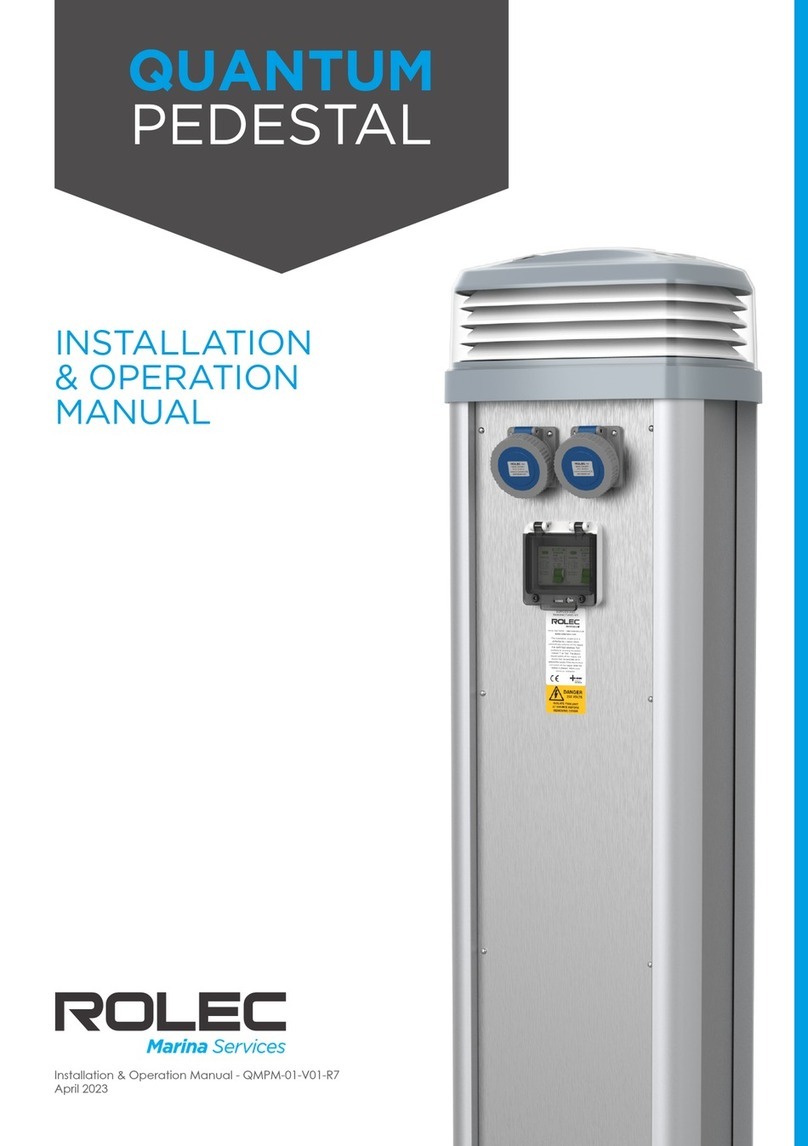
ROLEC
ROLEC QUANTUM PEDESTAL Installation & operation manual
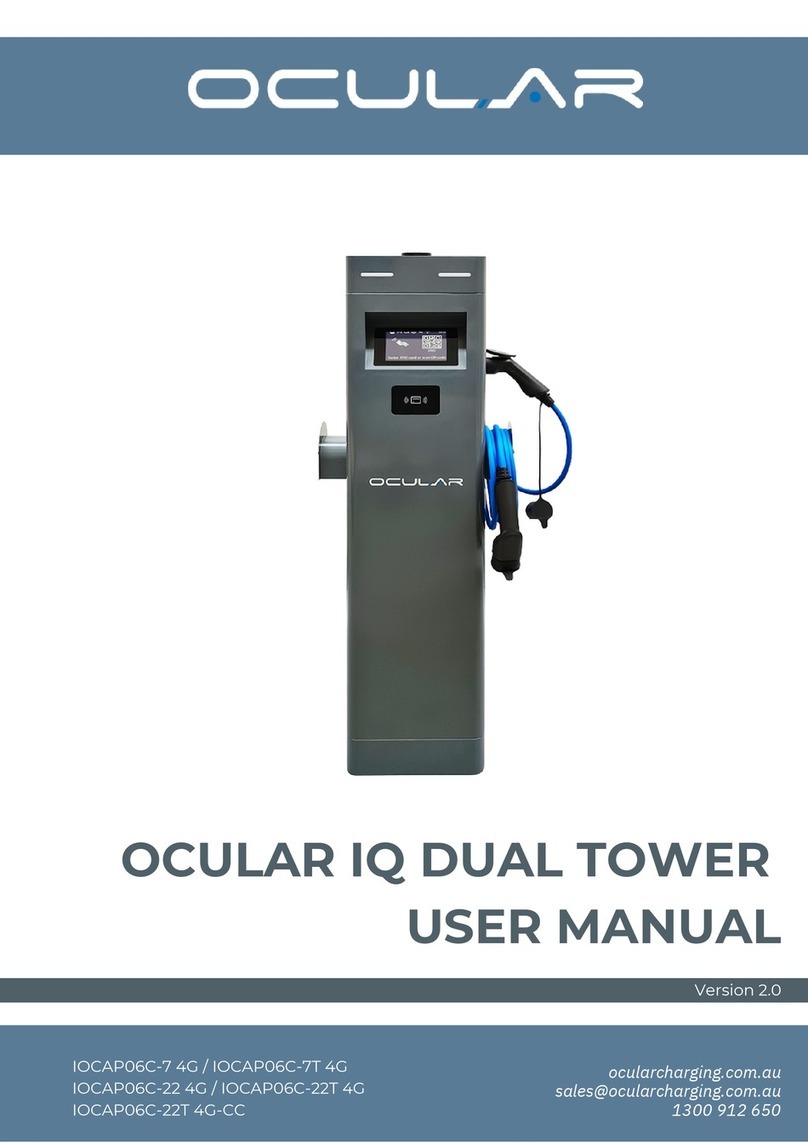
Ocular
Ocular IOCAP06C-7 4G user manual
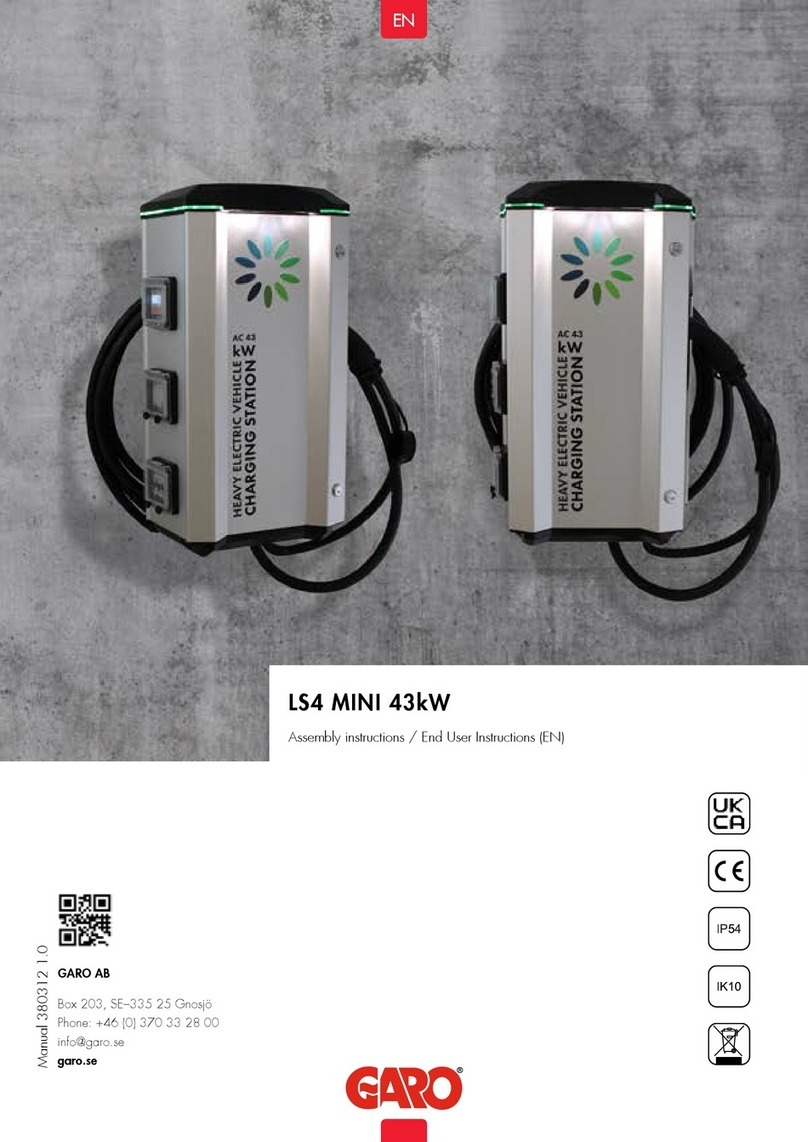
GARO
GARO LS4 MINI 43kW Assembly instructions

TRUCK PAC
TRUCK PAC ES1224 user manual
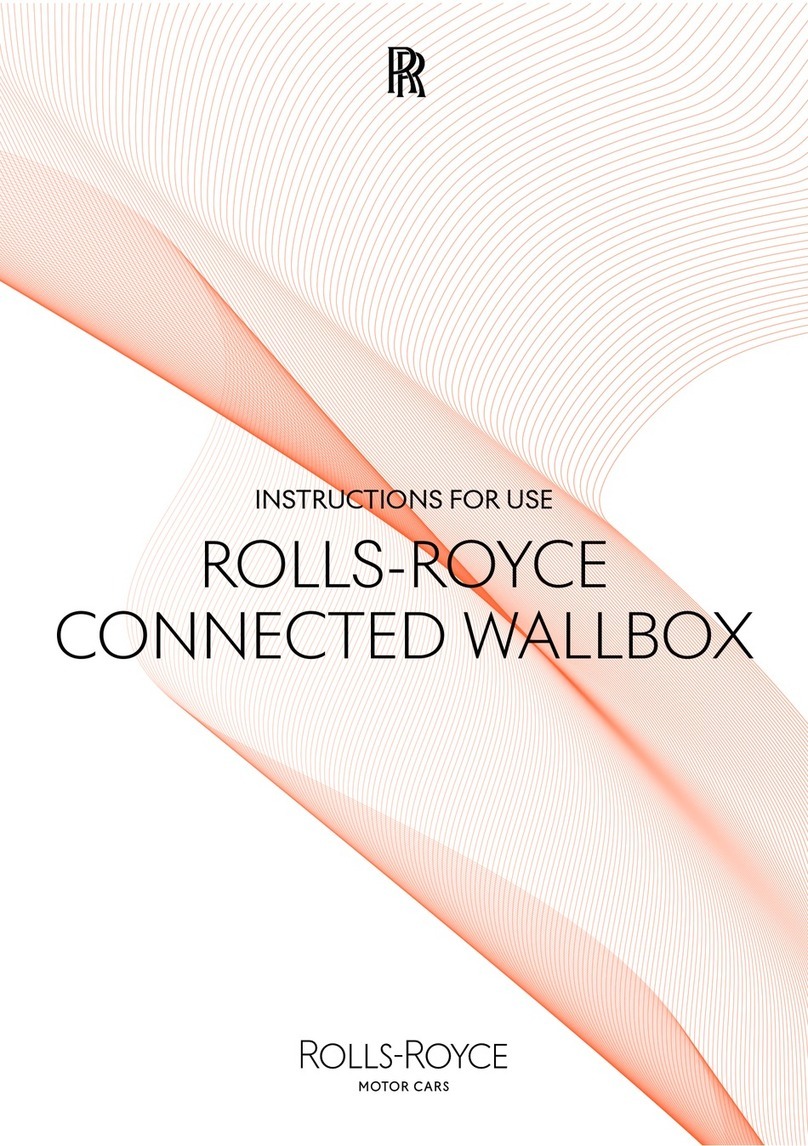
Rolls-Royce
Rolls-Royce 61 90 5A7A891 Instructions for use
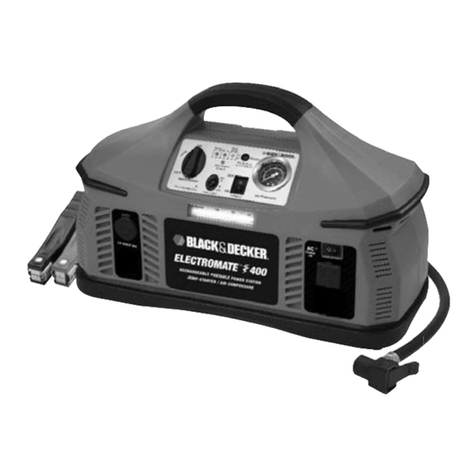
Black & Decker
Black & Decker ElectroMate 90556511 instruction manual
